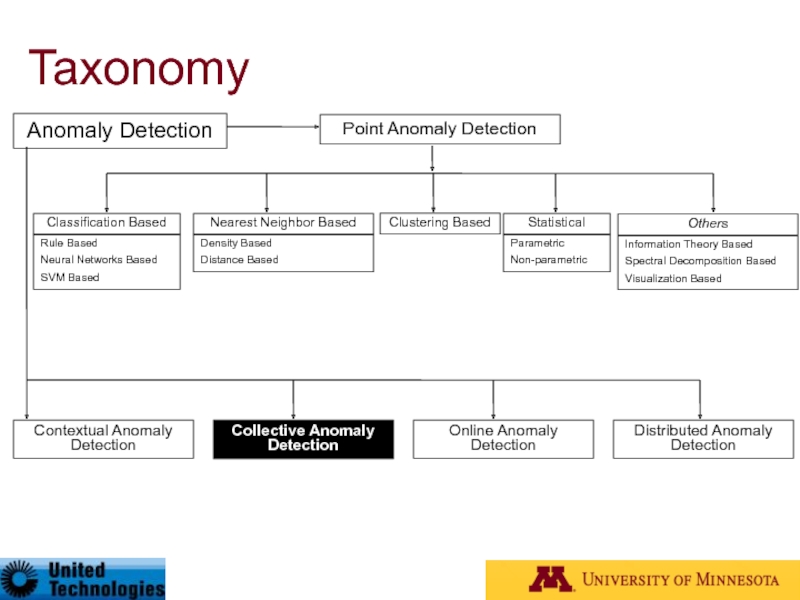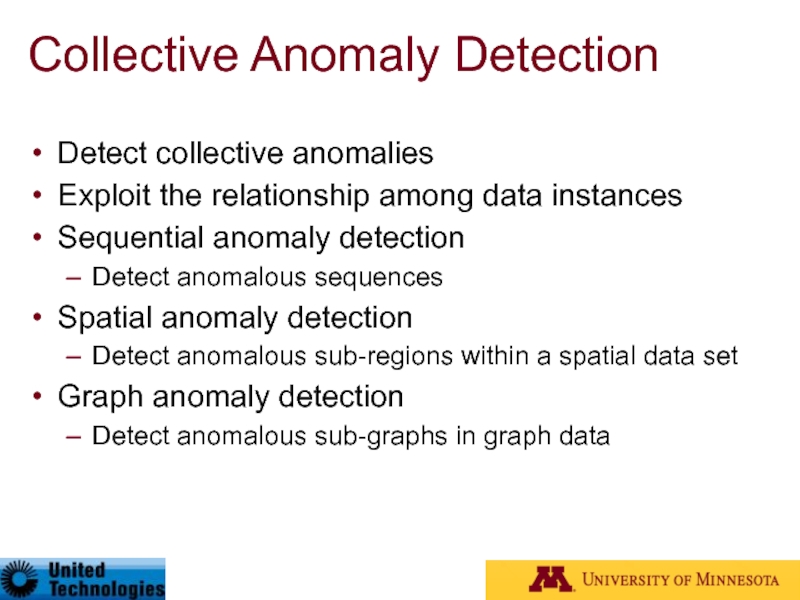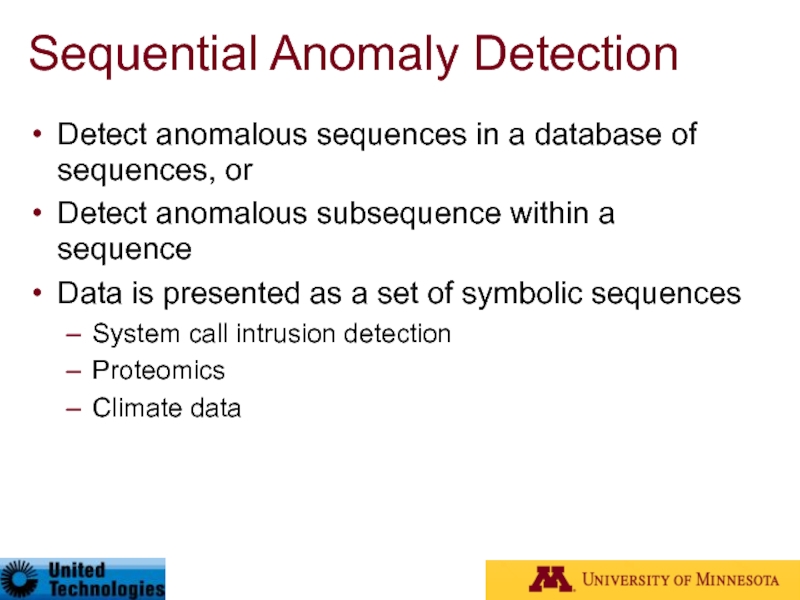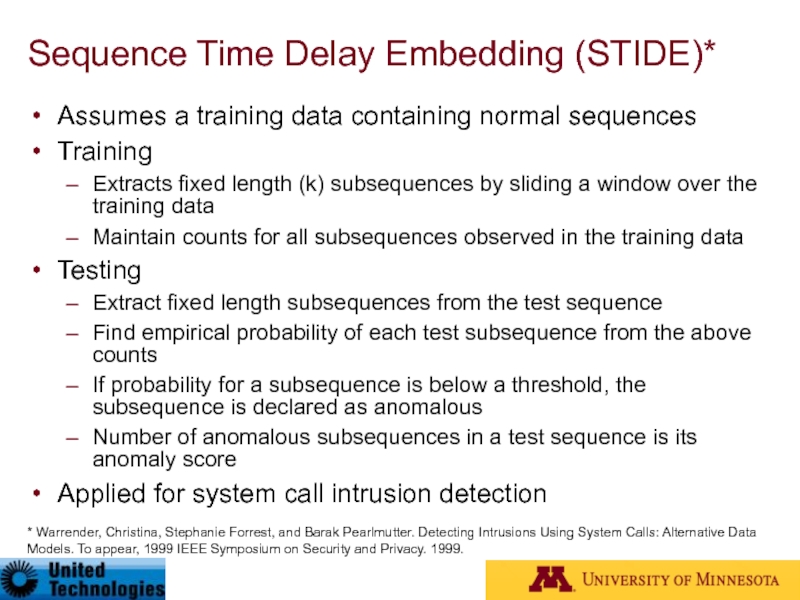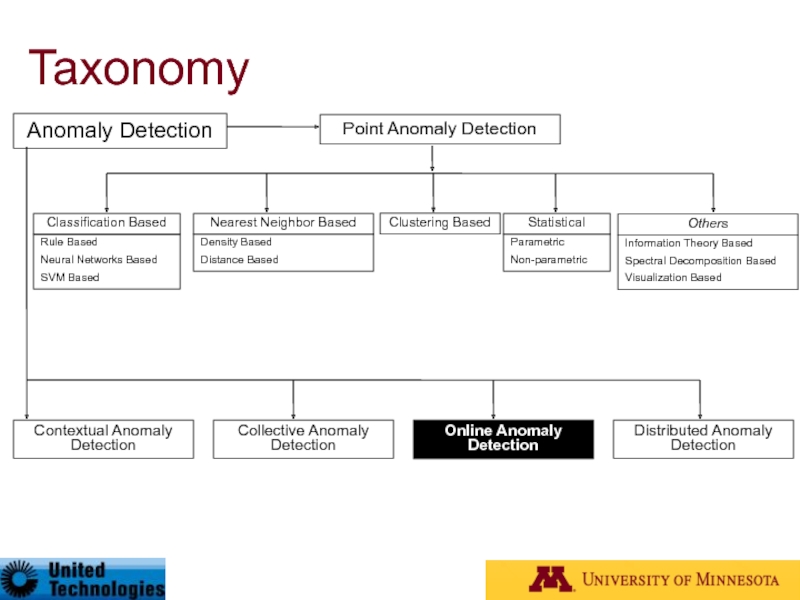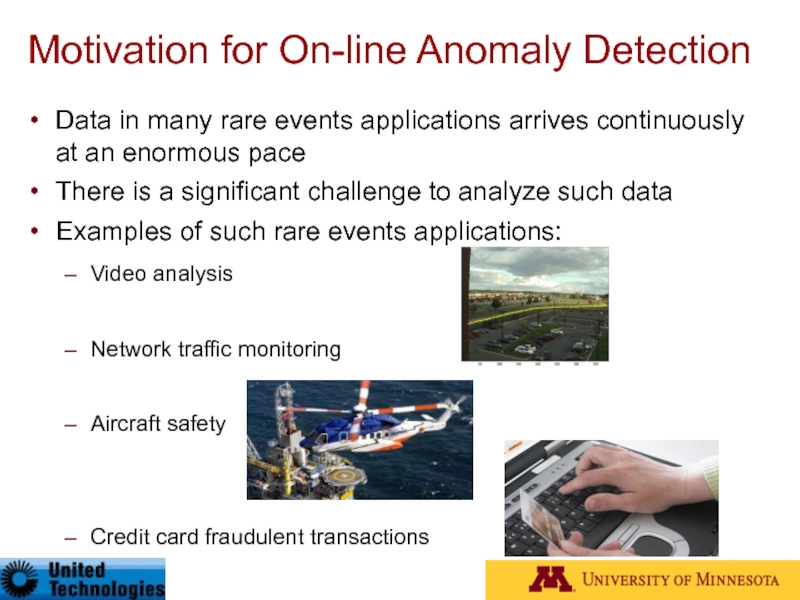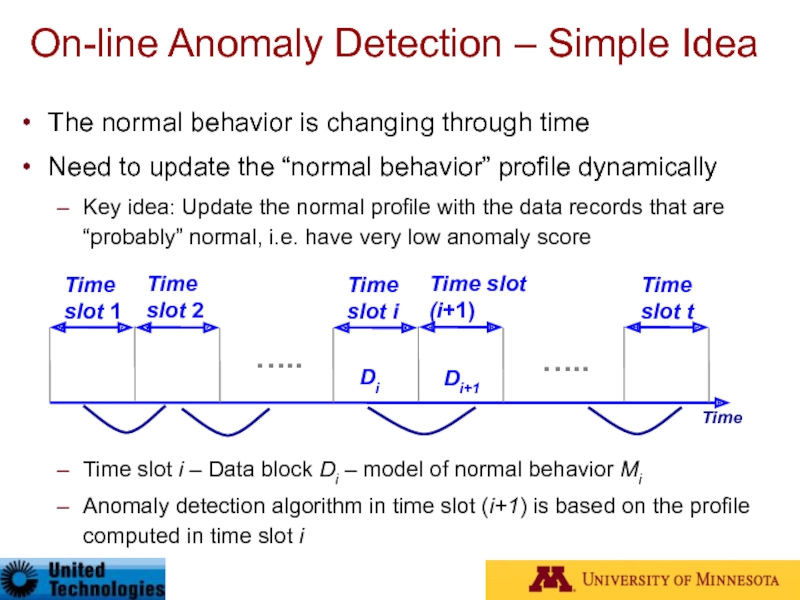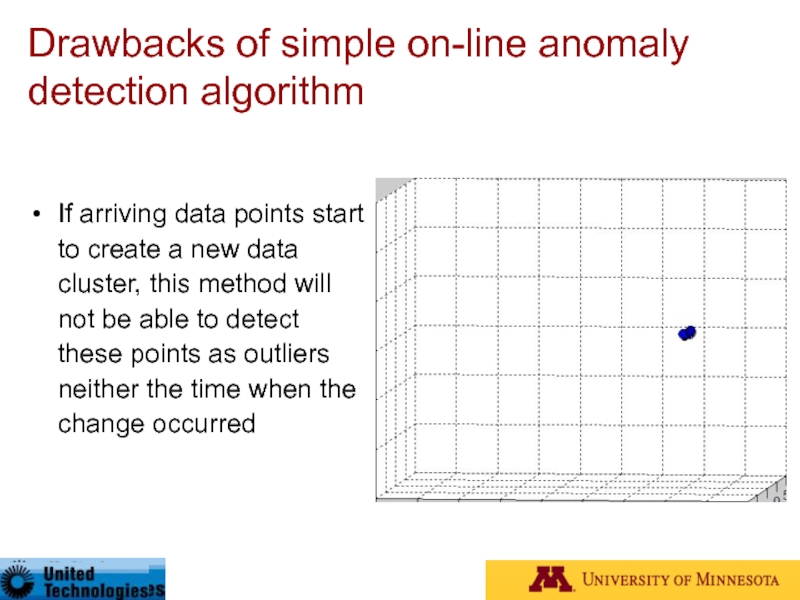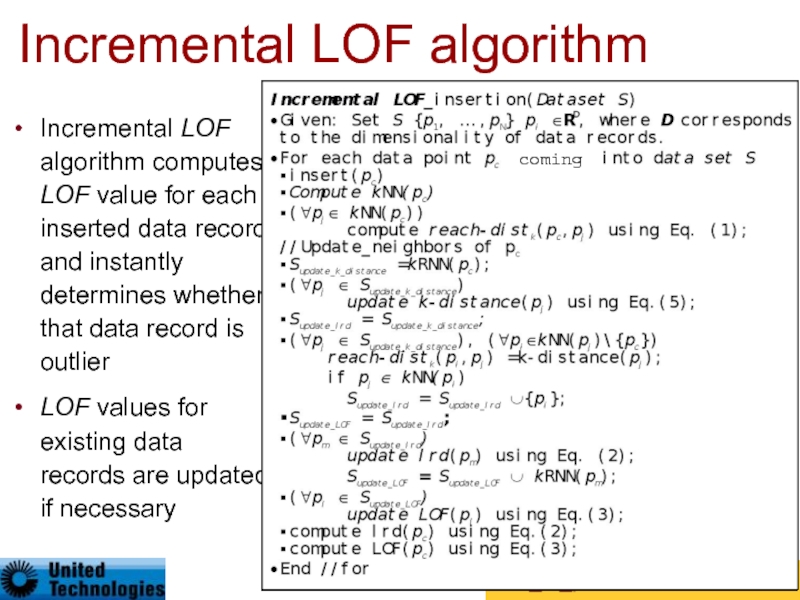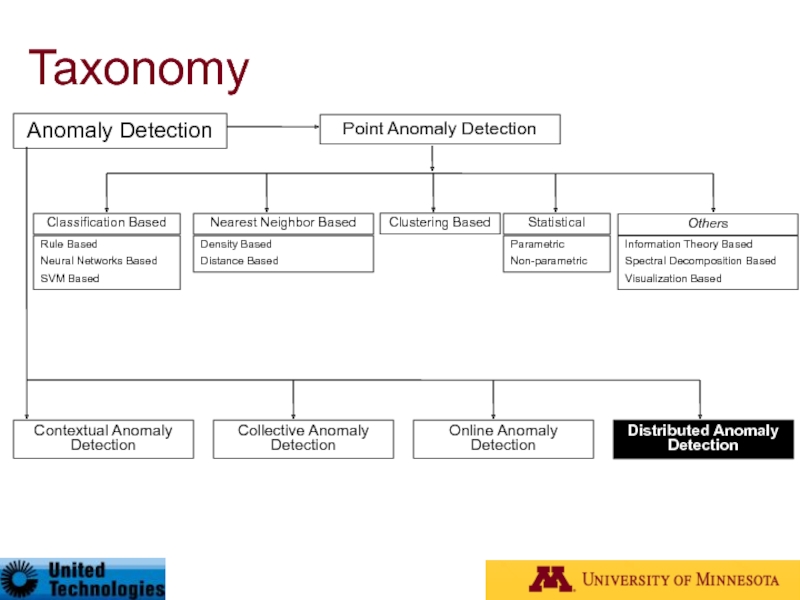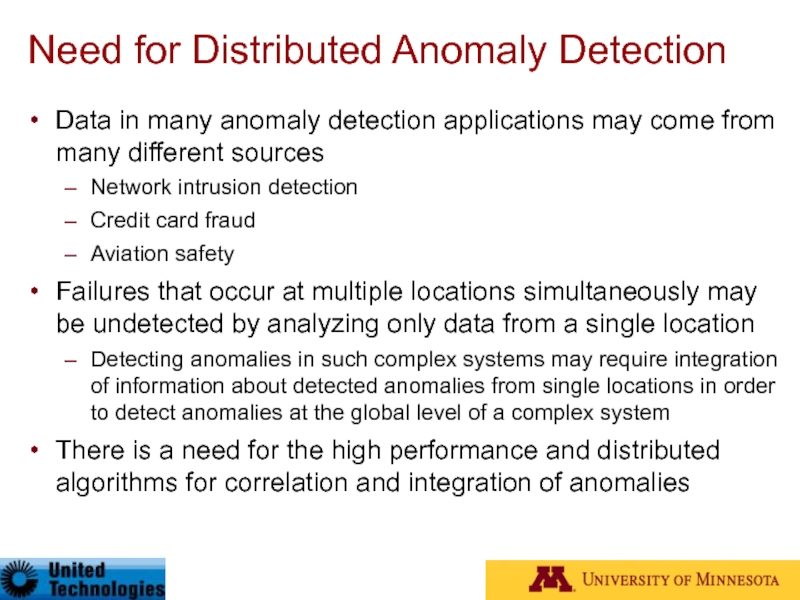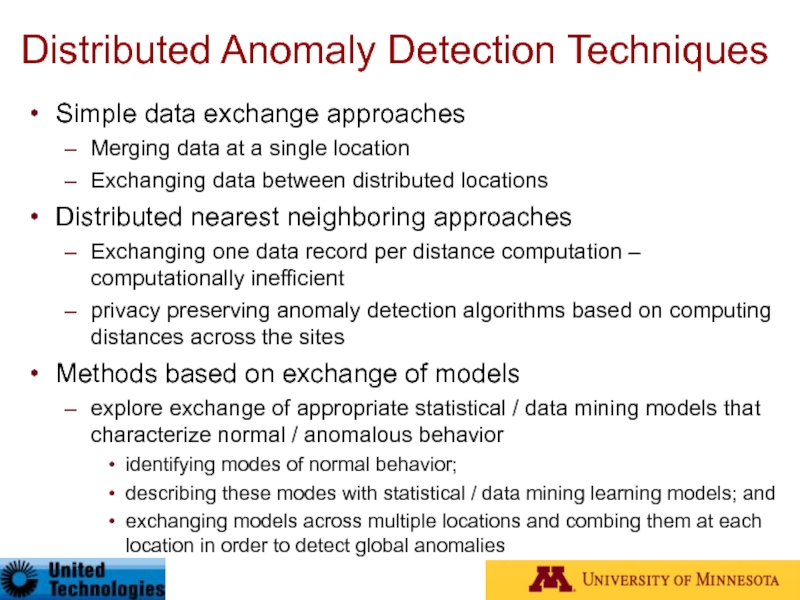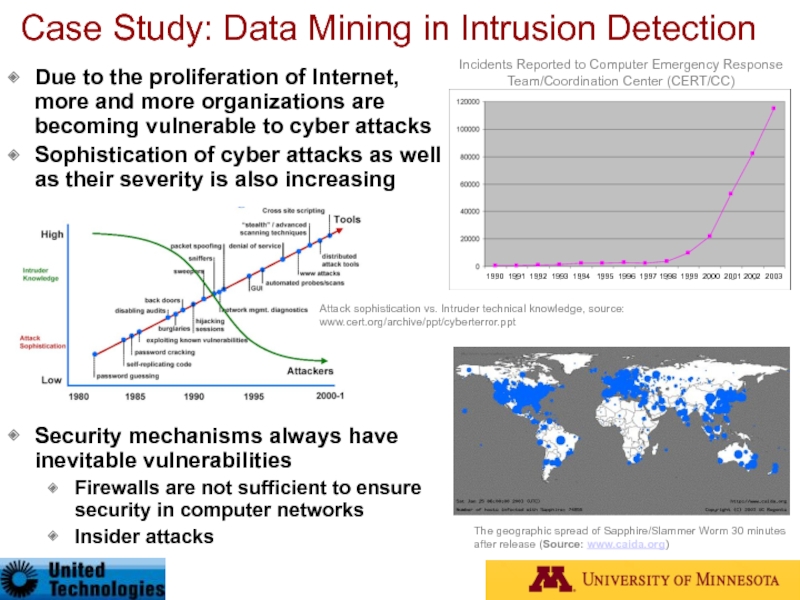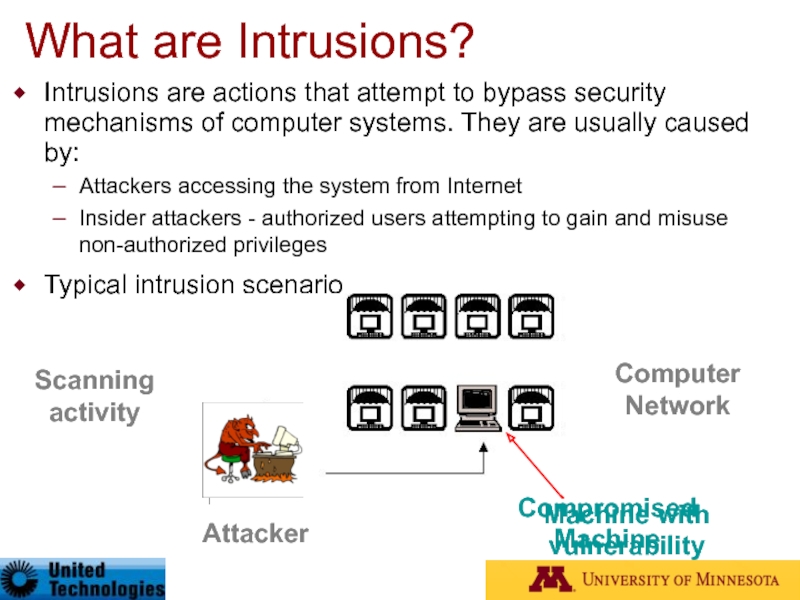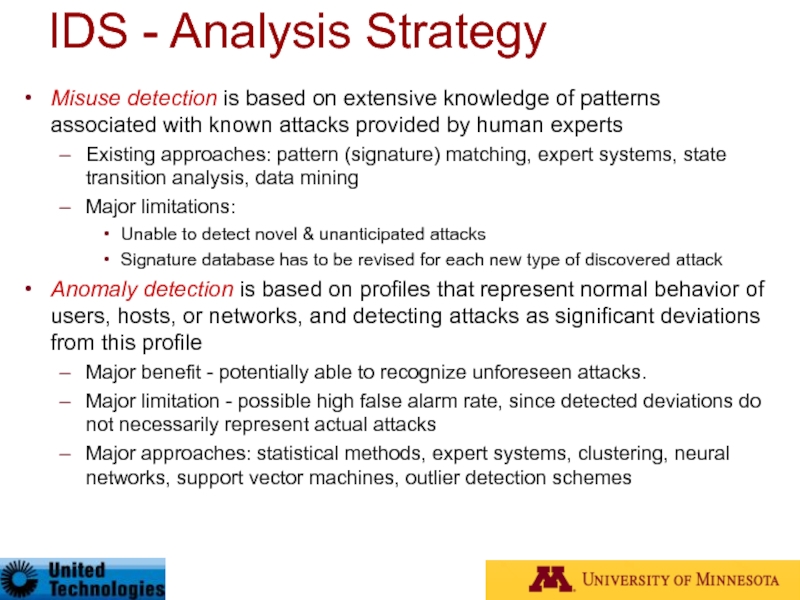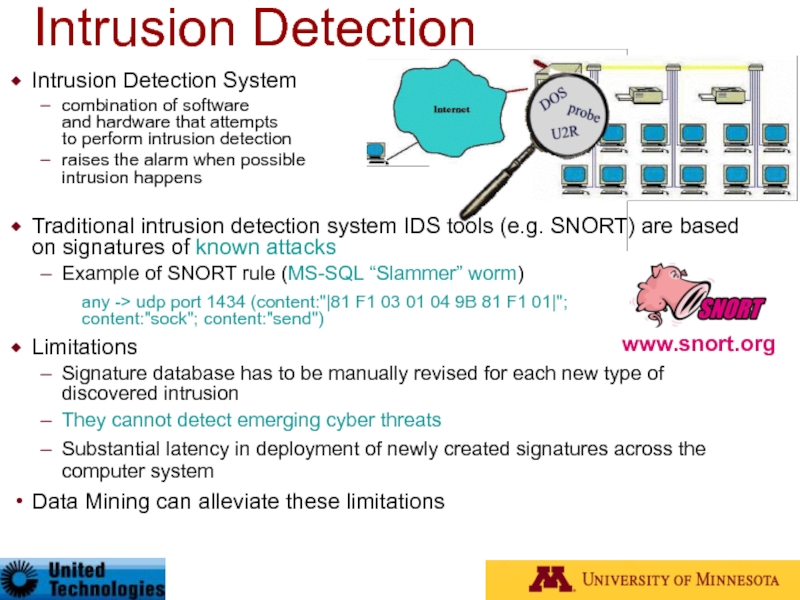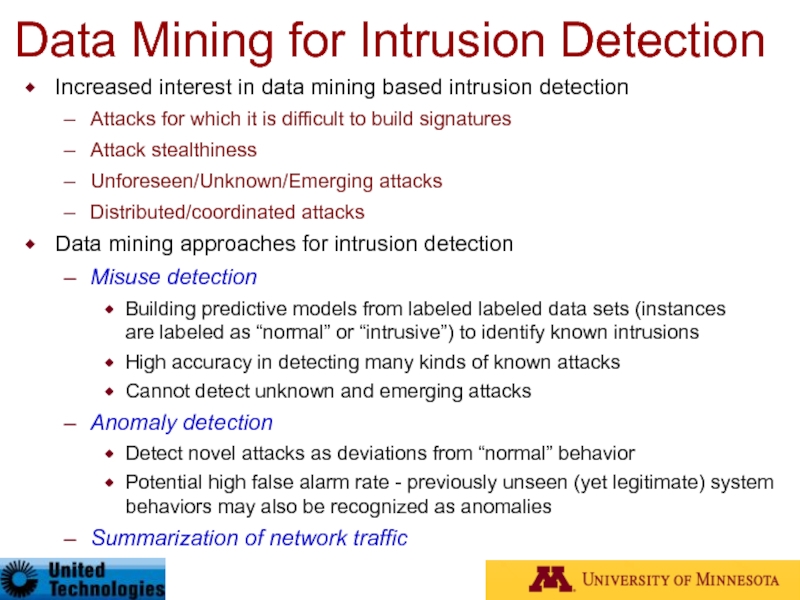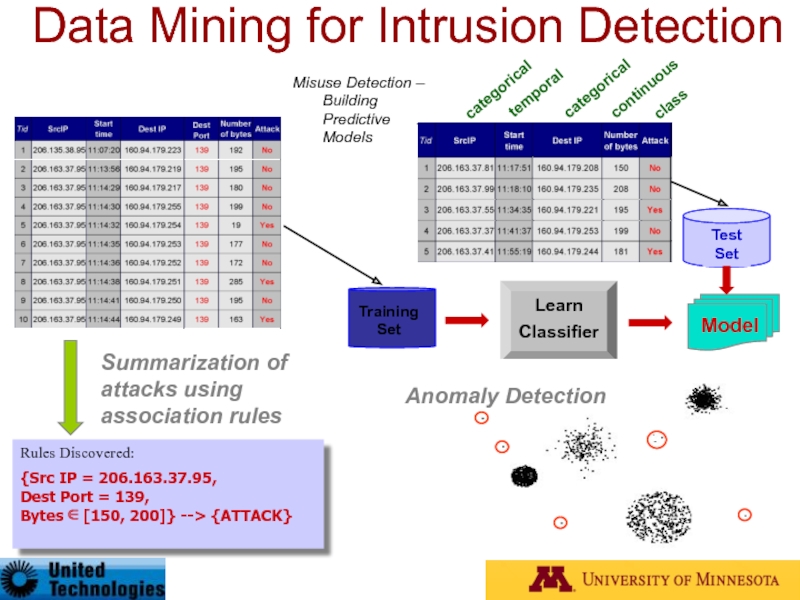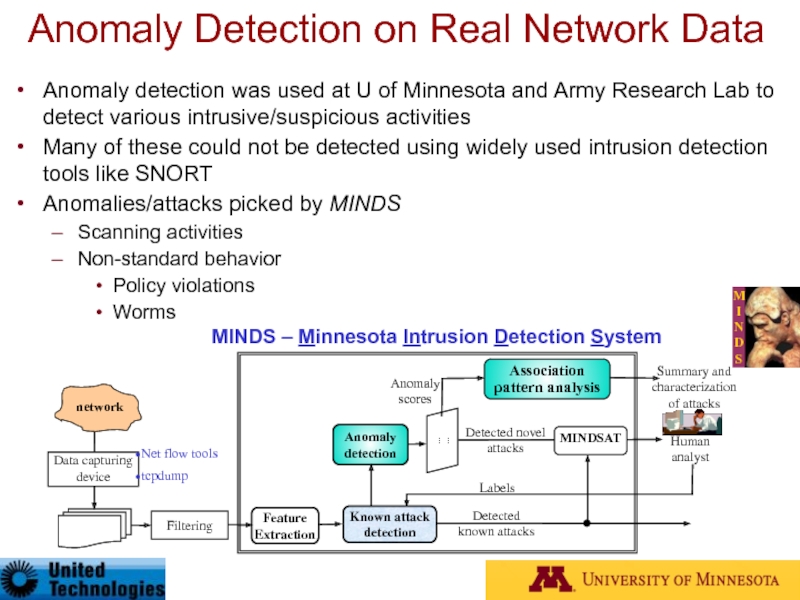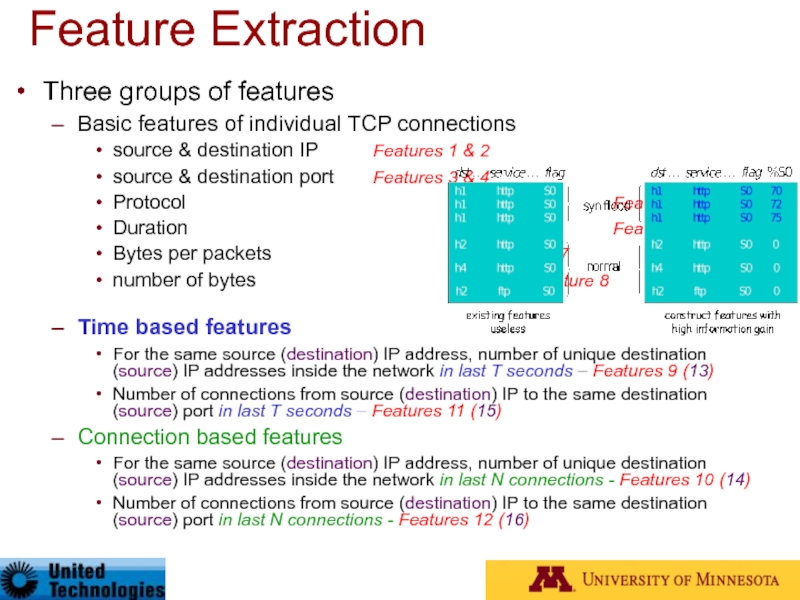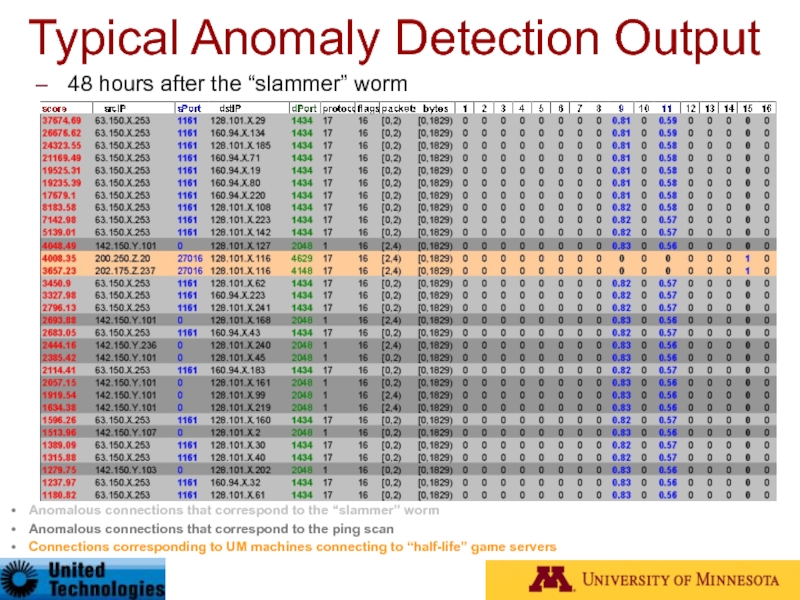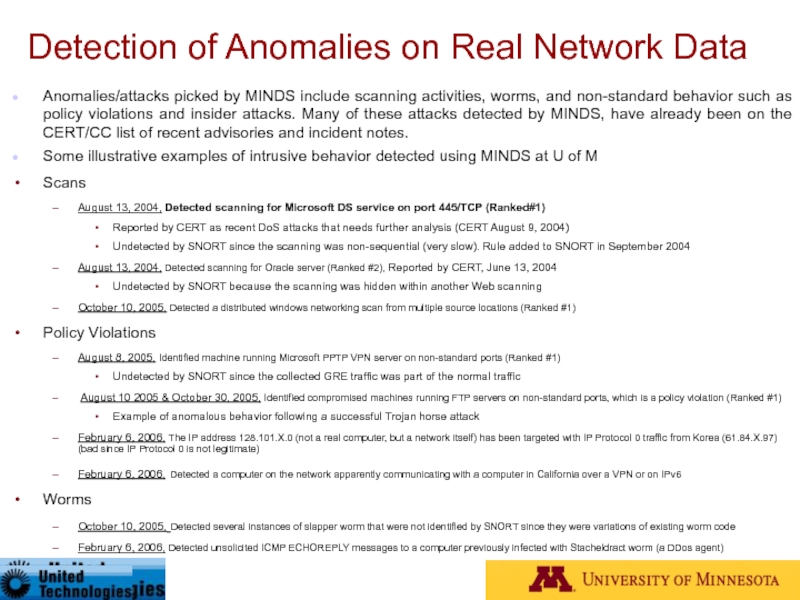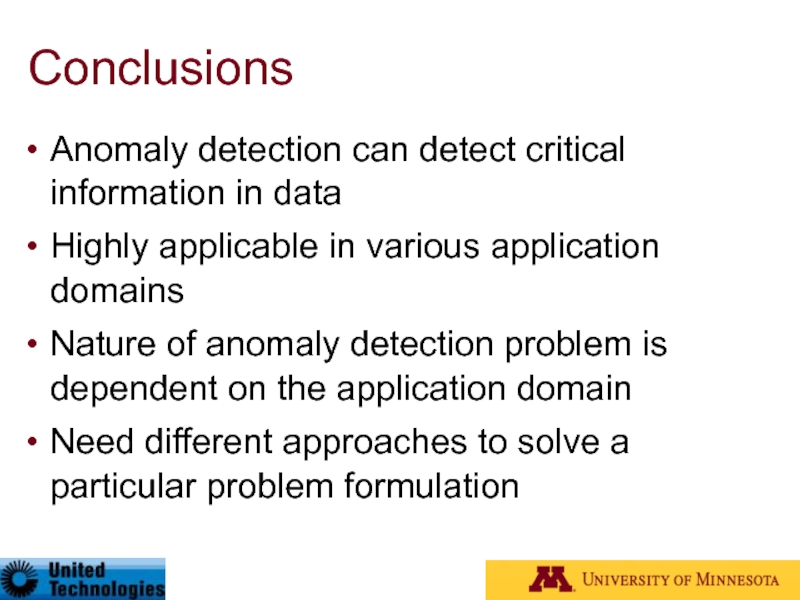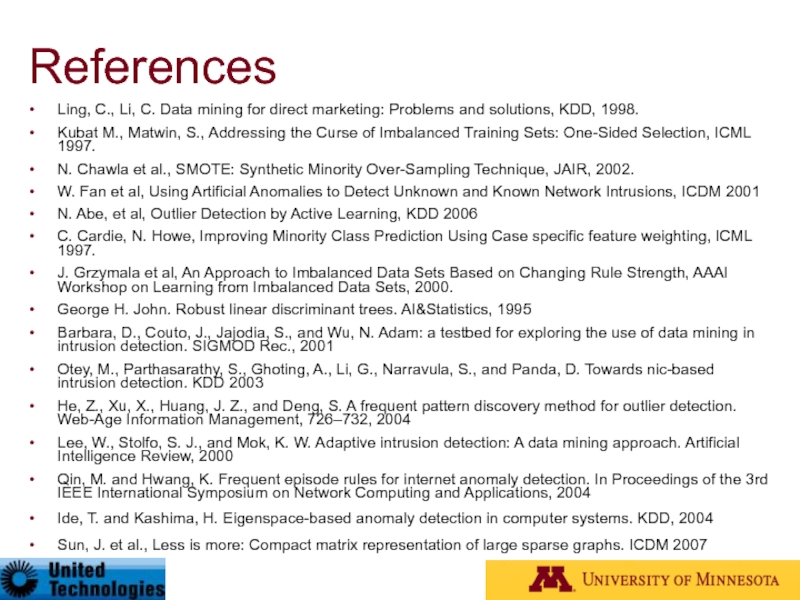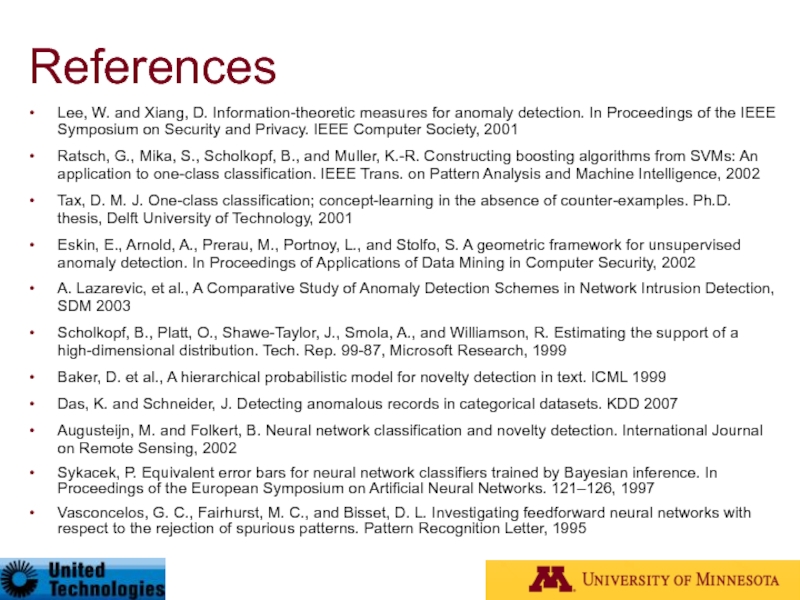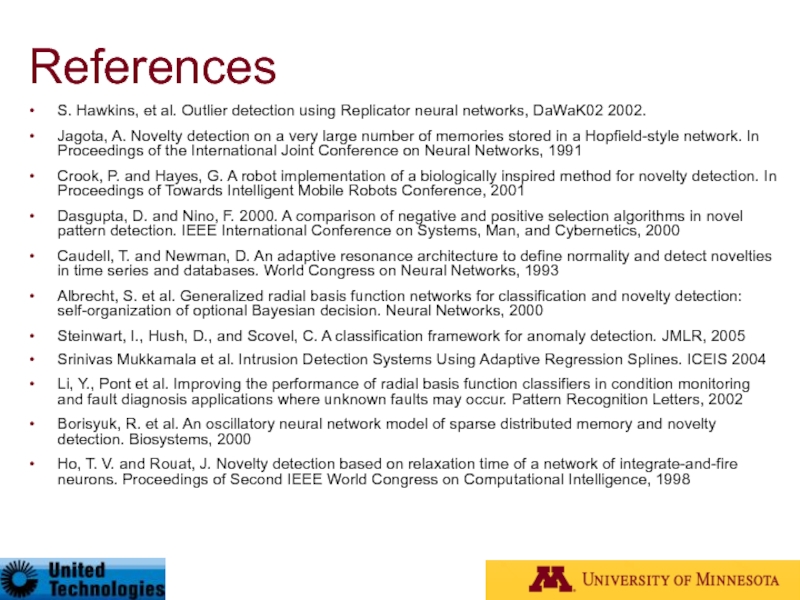- Главная
- Разное
- Дизайн
- Бизнес и предпринимательство
- Аналитика
- Образование
- Развлечения
- Красота и здоровье
- Финансы
- Государство
- Путешествия
- Спорт
- Недвижимость
- Армия
- Графика
- Культурология
- Еда и кулинария
- Лингвистика
- Английский язык
- Астрономия
- Алгебра
- Биология
- География
- Детские презентации
- Информатика
- История
- Литература
- Маркетинг
- Математика
- Медицина
- Менеджмент
- Музыка
- МХК
- Немецкий язык
- ОБЖ
- Обществознание
- Окружающий мир
- Педагогика
- Русский язык
- Технология
- Физика
- Философия
- Химия
- Шаблоны, картинки для презентаций
- Экология
- Экономика
- Юриспруденция
Anomaly detection презентация
Содержание
- 1. Anomaly detection
- 2. Outline Introduction Aspects of Anomaly Detection Problem
- 3. Introduction We are drowning in the deluge
- 4. What are Anomalies? Anomaly is a pattern
- 5. Real World Anomalies Credit Card Fraud An
- 6. Simple Example N1 and N2 are regions
- 7. Related problems Rare Class Mining Chance discovery
- 8. Key Challenges Defining a representative normal region
- 9. Aspects of Anomaly Detection Problem Nature of
- 10. Input Data Most common form of data
- 11. Input Data – Nature of Attributes Nature
- 12. Input Data – Complex Data Types Relationship
- 13. Data Labels Supervised Anomaly Detection Labels available
- 14. Type of Anomaly Point Anomalies Contextual Anomalies Collective Anomalies
- 15. Point Anomalies An individual data instance is anomalous w.r.t. the data
- 16. Contextual Anomalies An individual data instance is
- 17. Collective Anomalies A collection of related data
- 18. Output of Anomaly Detection Label Each test
- 19. Evaluation of Anomaly Detection – F-value Accuracy
- 20. Evaluation of Outlier Detection – ROC &
- 21. Applications of Anomaly Detection Network intrusion detection
- 22. Intrusion Detection Intrusion Detection: Process of
- 23. Fraud Detection Fraud detection refers to detection
- 24. Healthcare Informatics Detect anomalous patient records Indicate
- 25. Industrial Damage Detection Industrial damage detection refers
- 26. Image Processing Detecting outliers in a image
- 27. Taxonomy* Anomaly Detection Contextual Anomaly Detection Collective
- 28. Classification Based Techniques Main idea: build a
- 29. Classification Based Techniques Advantages: Supervised classification techniques
- 30. Supervised Classification Techniques Manipulating data records (oversampling
- 31. Manipulating Data Records Over-sampling the rare class
- 32. Rule Based Techniques Creating new rule based
- 33. New Rule-based Algorithms: PN-rule Learning* P-phase: cover
- 34. New Rule-based Algorithms: CREDOS* Ripple Down Rules
- 35. Using Neural Networks Multi-layer Perceptrons Measuring the
- 36. Using Support Vector Machines SVM Classifiers [Steinwart05,Mukkamala02]
- 37. Using Bayesian Networks Typical Bayesian networks
- 38. Semi-supervised Classification Techniques Use modified classification model
- 39. Using Replicator Neural Networks* Use a replicator
- 40. Using Support Vector Machines Converting into one
- 41. Taxonomy Anomaly Detection Contextual Anomaly Detection Collective
- 42. Nearest Neighbor Based Techniques Key assumption: normal
- 43. Nearest Neighbor Based Techniques Advantage Can be
- 44. Nearest Neighbor Based Techniques Distance based approaches
- 45. Distance based Outlier Detection Nearest Neighbor (NN)
- 46. Local Outlier Factor (LOF)* For each
- 47. Advantages of Density based Techniques Local Outlier
- 48. Connectivity Outlier Factor (COF)* Outliers are points
- 49. Multi-Granularity Deviation Factor - LOCI* LOCI
- 50. Taxonomy Anomaly Detection Contextual Anomaly Detection Collective
- 51. Clustering Based Techniques Key assumption: normal data
- 52. Clustering Based Techniques Advantages: No need to
- 53. Simple Application of Clustering Radius ω of
- 54. FindOut algorithm* by-product of WaveCluster Main idea:
- 55. Cluster based Local Outlier Factor (CBLOF) Use
- 56. Taxonomy Anomaly Detection Contextual Anomaly Detection Collective
- 57. Statistics Based Techniques Data points are modeled
- 58. Types of Statistical Techniques Parametric Techniques Assume
- 59. SmartSifter (SS)* Uses Finite Mixtures SS
- 60. Using Probability Distributions* Basic Assumption: # of
- 61. Taxonomy Anomaly Detection Contextual Anomaly Detection Collective
- 62. Information Theory Based Techniques Compute information content
- 63. Using a variety of information theoretic measures
- 64. Using Information Theoretic Measures* Entropy measures the
- 65. Spectral Techniques Analysis based on eigen decomposition
- 66. Using Robust PCA* Variability analysis based on
- 67. Temporal analysis of dynamic graphs Based
- 68. Visualization Based Techniques Use visualization tools to
- 69. Application of Dynamic Graphics* Apply dynamic graphics
- 70. Visual Data Mining* Detecting Tele-communication fraud
- 71. Taxonomy Anomaly Detection Contextual Anomaly Detection Collective
- 72. Contextual Anomaly Detection Detect context anomalies General
- 73. Contextual Anomaly Detection Advantages Detect anomalies that
- 74. Contextual Attributes Contextual attributes define a neighborhood
- 75. Contextual Anomaly Detection Techniques Techniques Reduction to
- 76. Conditional Anomaly Detection* Each data point is
- 77. Taxonomy Anomaly Detection Contextual Anomaly Detection Collective
- 78. Collective Anomaly Detection Detect collective anomalies Exploit
- 79. Sequential Anomaly Detection Detect anomalous sequences in
- 80. Sequence Time Delay Embedding (STIDE)* Assumes a
- 81. Taxonomy Anomaly Detection Contextual Anomaly Detection Collective
- 82. Motivation for On-line Anomaly Detection Data in
- 83. On-line Anomaly Detection – Simple Idea The
- 84. Drawbacks of simple on-line anomaly detection algorithm
- 85. Incremental LOF algorithm Incremental LOF algorithm computes
- 86. Taxonomy Anomaly Detection Contextual Anomaly Detection Collective
- 87. Need for Distributed Anomaly Detection Data in
- 88. Distributed Anomaly Detection Techniques Simple data exchange
- 89. Case Study: Data Mining in Intrusion Detection
- 90. What are Intrusions? Intrusions are actions that
- 91. IDS - Analysis Strategy Misuse detection is
- 92. Intrusion Detection www.snort.org Intrusion Detection System
- 93. Data Mining for Intrusion Detection Increased interest
- 94. Data Mining for Intrusion Detection Misuse Detection
- 95. Anomaly Detection on Real Network Data Anomaly
- 96. Three groups of features Basic features of
- 97. Typical Anomaly Detection Output 48 hours
- 98. Detection of Anomalies on Real Network Data
- 99. Conclusions Anomaly detection can detect critical information
- 100. References Ling, C., Li, C. Data mining
- 101. References Lee, W. and Xiang, D. Information-theoretic
- 102. References S. Hawkins, et al. Outlier detection
- 103. Thanks!!! Questions?
Слайд 1Anomaly Detection: A Tutorial
Arindam Banerjee, Varun Chandola, Vipin Kumar, Jaideep Srivastava
University
Aleksandar Lazarevic
United Technology Research Center
Слайд 2Outline
Introduction
Aspects of Anomaly Detection Problem
Applications
Different Types of Anomaly Detection
Case Studies
Discussion and
Слайд 3Introduction
We are drowning in the deluge of data that are being
Anomalous events occur relatively infrequently
However, when they do occur, their consequences can be quite dramatic and quite often in a negative sense
* - J. Naisbitt, Megatrends: Ten New Directions Transforming Our Lives. New York: Warner Books, 1982.
Слайд 4What are Anomalies?
Anomaly is a pattern in the data that does
Also referred to as outliers, exceptions, peculiarities, surprise, etc.
Anomalies translate to significant (often critical) real life entities
Cyber intrusions
Credit card fraud
Слайд 5Real World Anomalies
Credit Card Fraud
An abnormally high purchase made on a
Cyber Intrusions
A web server involved in ftp traffic
Слайд 6Simple Example
N1 and N2 are regions of normal behavior
Points o1 and
Points in region O3 are anomalies
Слайд 7Related problems
Rare Class Mining
Chance discovery
Novelty Detection
Exception Mining
Noise Removal
Black Swan*
* N. Talleb,
Слайд 8Key Challenges
Defining a representative normal region is challenging
The boundary between normal
The exact notion of an outlier is different for different application domains
Availability of labeled data for training/validation
Malicious adversaries
Data might contain noise
Normal behavior keeps evolving
Слайд 9Aspects of Anomaly Detection Problem
Nature of input data
Availability of supervision
Type of anomaly: point, contextual, structural
Output of anomaly detection
Evaluation of anomaly detection techniques
Слайд 10Input Data
Most common form of data handled by anomaly detection techniques
Univariate
Multivariate
Слайд 11Input Data – Nature of Attributes
Nature of attributes
Binary
Categorical
Continuous
Hybrid
categorical
continuous
continuous
categorical
binary
Слайд 12Input Data – Complex Data Types
Relationship among data instances
Sequential
Temporal
Spatial
Spatio-temporal
Graph
Слайд 13Data Labels
Supervised Anomaly Detection
Labels available for both normal data and anomalies
Similar
Semi-supervised Anomaly Detection
Labels available only for normal data
Unsupervised Anomaly Detection
No labels assumed
Based on the assumption that anomalies are very rare compared to normal data
Слайд 16Contextual Anomalies
An individual data instance is anomalous within a context
Requires a
Also referred to as conditional anomalies*
* Xiuyao Song, Mingxi Wu, Christopher Jermaine, Sanjay Ranka, Conditional Anomaly Detection, IEEE Transactions on Data and Knowledge Engineering, 2006.
Normal
Anomaly
Слайд 17Collective Anomalies
A collection of related data instances is anomalous
Requires a relationship
Sequential Data
Spatial Data
Graph Data
The individual instances within a collective anomaly are not anomalous by themselves
Anomalous Subsequence
Слайд 18Output of Anomaly Detection
Label
Each test instance is given a normal or
This is especially true of classification-based approaches
Score
Each test instance is assigned an anomaly score
Allows the output to be ranked
Requires an additional threshold parameter
Слайд 19Evaluation of Anomaly Detection – F-value
Accuracy is not sufficient metric for
Example: network traffic data set with 99.9% of normal data and 0.1% of intrusions
Trivial classifier that labels everything with the normal class can achieve 99.9% accuracy !!!!!
anomaly class – C
normal class – NC
Focus on both recall and precision
Recall (R) = TP/(TP + FN)
Precision (P) = TP/(TP + FP)
F – measure = 2*R*P/(R+P)
Слайд 20Evaluation of Outlier Detection – ROC & AUC
Standard measures for evaluating
Recall (Detection rate) - ratio between the number of correctly detected anomalies and the total number of anomalies
False alarm (false positive) rate – ratio between the number of data records from normal class that are misclassified as anomalies and the total number of data records from normal class
ROC Curve is a trade-off between detection rate and false alarm rate
Area under the ROC curve (AUC) is computed using a trapezoid rule
anomaly class – C
normal class – NC
Слайд 21Applications of Anomaly Detection
Network intrusion detection
Insurance / Credit card fraud detection
Healthcare
Industrial Damage Detection
Image Processing / Video surveillance
Novel Topic Detection in Text Mining
…
Слайд 22Intrusion Detection
Intrusion Detection:
Process of monitoring the events occurring in a
Intrusions are defined as attempts to bypass the security mechanisms of a computer or network
Challenges
Traditional signature-based intrusion detection systems are based on signatures of known attacks and cannot detect emerging cyber threats
Substantial latency in deployment of newly created signatures across the computer system
Anomaly detection can alleviate these limitations
Слайд 23Fraud Detection
Fraud detection refers to detection of criminal activities occurring in
Malicious users might be the actual customers of the organization or might be posing as a customer (also known as identity theft).
Types of fraud
Credit card fraud
Insurance claim fraud
Mobile / cell phone fraud
Insider trading
Challenges
Fast and accurate real-time detection
Misclassification cost is very high
Слайд 24Healthcare Informatics
Detect anomalous patient records
Indicate disease outbreaks, instrumentation errors, etc.
Key Challenges
Only
Misclassification cost is very high
Data can be complex: spatio-temporal
Слайд 25Industrial Damage Detection
Industrial damage detection refers to detection of different faults
Example: Aircraft Safety
Anomalous Aircraft (Engine) / Fleet Usage
Anomalies in engine combustion data
Total aircraft health and usage management
Key Challenges
Data is extremely huge, noisy and unlabelled
Most of applications exhibit temporal behavior
Detecting anomalous events typically require immediate intervention
Слайд 26Image Processing
Detecting outliers in a image monitored over time
Detecting anomalous regions
Used in
mammography image analysis
video surveillance
satellite image analysis
Key Challenges
Detecting collective anomalies
Data sets are very large
Anomaly
Слайд 27Taxonomy*
Anomaly Detection
Contextual Anomaly Detection
Collective Anomaly Detection
Online Anomaly Detection
Distributed Anomaly Detection
Point Anomaly
Classification Based
Rule Based
Neural Networks Based
SVM Based
Nearest Neighbor Based
Density Based
Distance Based
Statistical
Parametric
Non-parametric
Clustering Based
Others
Information Theory Based
Spectral Decomposition Based
Visualization Based
* Outlier Detection – A Survey, Varun Chandola, Arindam Banerjee, and Vipin Kumar, Technical Report TR07-17, University of Minnesota (Under Review)
Слайд 28Classification Based Techniques
Main idea: build a classification model for normal (and
Classification models must be able to handle skewed (imbalanced) class distributions
Categories:
Supervised classification techniques
Require knowledge of both normal and anomaly class
Build classifier to distinguish between normal and known anomalies
Semi-supervised classification techniques
Require knowledge of normal class only!
Use modified classification model to learn the normal behavior and then detect any deviations from normal behavior as anomalous
Слайд 29Classification Based Techniques
Advantages:
Supervised classification techniques
Models that can be easily understood
High accuracy
Semi-supervised classification techniques
Models that can be easily understood
Normal behavior can be accurately learned
Drawbacks:
Supervised classification techniques
Require both labels from both normal and anomaly class
Cannot detect unknown and emerging anomalies
Semi-supervised classification techniques
Require labels from normal class
Possible high false alarm rate - previously unseen (yet legitimate) data records may be recognized as anomalies
Слайд 30Supervised Classification Techniques
Manipulating data records (oversampling / undersampling / generating artificial
Rule based techniques
Model based techniques
Neural network based approaches
Support Vector machines (SVM) based approaches
Bayesian networks based approaches
Cost-sensitive classification techniques
Ensemble based algorithms (SMOTEBoost, RareBoost
Слайд 31Manipulating Data Records
Over-sampling the rare class [Ling98]
Make the duplicates of the
Does not increase information but increase misclassification cost
Down-sizing (undersampling) the majority class [Kubat97]
Sample the data records from majority class (Randomly, Near miss examples, Examples far from minority class examples (far from decision boundaries)
Introduce sampled data records into the original data set instead of original data records from the majority class
Usually results in a general loss of information and overly general rules
Generating artificial anomalies
SMOTE (Synthetic Minority Over-sampling TEchnique) [Chawla02] - new rare class examples are generated inside the regions of existing rare class examples
Artificial anomalies are generated around the edges of the sparsely populated data regions [Fan01]
Classify synthetic outliers vs. real normal data using active learning [Abe06]
Слайд 32Rule Based Techniques
Creating new rule based algorithms (PN-rule, CREDOS)
Adapting existing rule
Robust C4.5 algorithm [John95]
Adapting multi-class classification methods to single-class classification problem
Association rules
Rules with support higher than pre specified threshold may characterize normal behavior [Barbara01, Otey03]
Anomalous data record occurs in fewer frequent itemsets compared to normal data record [He04]
Frequent episodes for describing temporal normal behavior [Lee00,Qin04]
Case specific feature/rule weighting
Case specific feature weighting [Cardey97] - Decision tree learning, where for each rare class test example replace global weight vector with dynamically generated weight vector that depends on the path taken by that example
Case specific rule weighting [Grzymala00] - LERS (Learning from Examples based on Rough Sets) algorithm increases the rule strength for all rules describing the rare class
Слайд 33New Rule-based Algorithms: PN-rule Learning*
P-phase:
cover most of the positive examples with
seek good recall
N-phase:
remove FP from examples covered in P-phase
N-rules give high accuracy and significant support
Existing techniques can possibly learn erroneous small signatures for absence of C
C
NC
PNrule can learn strong signatures for presence of NC in N-phase
C
NC
* M. Joshi, et al., PNrule, Mining Needles in a Haystack: Classifying Rare Classes via Two-Phase Rule Induction, ACM SIGMOD 2001
Слайд 34New Rule-based Algorithms: CREDOS*
Ripple Down Rules (RDRs) offer a unique tree
First use ripple down rules to overfit the training data
Generate a binary tree where each node is characterized by the rule Rh, a default class and links to two child subtrees
Grow the RDS structure in a recursive manner
Induces rules at a node
Prune the structure to improve generalization
Different mechanism from decision trees
* M. Joshi, et al., CREDOS: Classification Using Ripple Down Structure (A Case for Rare Classes), SIAM International Conference on Data Mining, (SDM'04), 2004.
Слайд 35Using Neural Networks
Multi-layer Perceptrons
Measuring the activation of output nodes [Augusteijn02]
Extending the
Equivalent error bars as a measure of confidence for classification [Sykacek97]
Creating hyper-planes for separating between various classes, but also to have flexible boundaries where points far from them are outliers [Vasconcelos95]
Auto-associative neural networks
Replicator NNs [Hawkins02]
Hopfield networks [Jagota91, Crook01]
Adaptive Resonance Theory based [Dasgupta00, Caudel93]
Radial Basis Functions based
Adding reverse connections from output to central layer allows each neuron to have associated normal distribution, and any new instance that does not fit any of these distributions is an anomaly [Albrecht00, Li02]
Oscillatory networks
Relaxation time of oscillatory NNs is used as a criterion for novelty detection when a new instance is presented [Ho98, Borisyuk00]
Слайд 36Using Support Vector Machines
SVM Classifiers [Steinwart05,Mukkamala02]
Main idea [Steinwart05] :
Normal data records
Anomalies belong to low density data regions
Use unsupervised approach to learn high density and low density data regions
Use SVM to classify data density level
Main idea: [Mukkamala02]
Data records are labeled (normal network behavior vs. intrusive)
Use standard SVM for classification
* A. Lazarevic, et al., A Comparative Study of Anomaly Detection Schemes in Network Intrusion Detection, SIAM 2003
Слайд 37Using Bayesian Networks
Typical Bayesian networks
Aggregates information from different variables and
Naïve Bayesian classifiers
Incorporate prior probabilities into a reasoning model that classifies an event as normal or anomalous based on observed properties of the event and prior probabilities [Sebyala02, Kruegel03]
Pseudo-Bayes estimators [Barbara01]
I stage: learn prior and posterior of unseen anomalies from the training data
II stage: use Naive Bayes classifier to classify the instances into normal instances, known anomalies and new anomalies
Слайд 38Semi-supervised Classification Techniques
Use modified classification model to learn the normal behavior
Recent approaches:
Neural network based approaches
Support Vector machines (SVM) based approaches
Markov model based approaches
Rule-based approaches
Слайд 39Using Replicator Neural Networks*
Use a replicator 4-layer feed-forward neural network (RNN)
Input variables are the output variables so that RNN forms a compressed model of the data during training
A measure of outlyingness is the reconstruction error of individual data points.
* S. Hawkins, et al. Outlier detection using replicator neural networks, DaWaK02 2002.
Слайд 40Using Support Vector Machines
Converting into one class classification problem
Separate the entire
Parameters
Expected number of outliers
Variance of rbf kernel (As the variance of the rbf kernel gets smaller, the number of support vectors is larger and the separating surface gets more complex)
Separate regions containing data from the regions containing no data [Scholkopf99]
push the hyper plane away from origin as much as possible
Слайд 41Taxonomy
Anomaly Detection
Contextual Anomaly Detection
Collective Anomaly Detection
Online Anomaly Detection
Distributed Anomaly Detection
Point Anomaly
Classification Based
Rule Based
Neural Networks Based
SVM Based
Nearest Neighbor Based
Density Based
Distance Based
Statistical
Parametric
Non-parametric
Clustering Based
Others
Information Theory Based
Spectral Decomposition Based
Visualization Based
Слайд 42Nearest Neighbor Based Techniques
Key assumption: normal points have close neighbors while
General two-step approach
Compute neighborhood for each data record
Analyze the neighborhood to determine whether data record is anomaly or not
Categories:
Distance based methods
Anomalies are data points most distant from other points
Density based methods
Anomalies are data points in low density regions
Слайд 43Nearest Neighbor Based Techniques
Advantage
Can be used in unsupervised or semi-supervised setting
Drawbacks
If normal points do not have sufficient number of neighbors the techniques may fail
Computationally expensive
In high dimensional spaces, data is sparse and the concept of similarity may not be meaningful anymore. Due to the sparseness, distances between any two data records may become quite similar => Each data record may be considered as potential outlier!
Слайд 44Nearest Neighbor Based Techniques
Distance based approaches
A point O in a dataset
Density based approaches
Compute local densities of particular regions and declare instances in low density regions as potential anomalies
Approaches
Local Outlier Factor (LOF)
Connectivity Outlier Factor (COF
Multi-Granularity Deviation Factor (MDEF)
*Knorr, Ng,Algorithms for Mining Distance-Based Outliers in Large Datasets, VLDB98
Слайд 45Distance based Outlier Detection
Nearest Neighbor (NN) approach*,**
For each data point d
Sort all data points according to the distance dk
Outliers are points that have the largest distance dk and therefore are located in the more sparse neighborhoods
Usually data points that have top n% distance dk are identified as outliers
n – user parameter
Not suitable for datasets that have modes with varying density
* Knorr, Ng,Algorithms for Mining Distance-Based Outliers in Large Datasets, VLDB98
** S. Ramaswamy, R. Rastogi, S. Kyuseok: Efficient Algorithms for Mining Outliers from Large Data Sets, ACM SIGMOD Conf. On Management of Data, 2000.
Слайд 46Local Outlier Factor (LOF)*
For each data point q compute the
Compute reachability distance (reach-dist) for each data example q with respect to data example p as:
reach-dist(q, p) = max{k-distance(p), d(q,p)}
Compute local reachability density (lrd) of data example q as inverse of the average reachabaility distance based on the MinPts nearest neighbors of data example q
lrd(q) =
Compaute LOF(q) as ratio of average local reachability density of q’s k-nearest neighbors and local reachability density of the data record q
LOF(q) =
* - Breunig, et al, LOF: Identifying Density-Based Local Outliers, KDD 2000.
Слайд 47Advantages of Density based Techniques
Local Outlier Factor (LOF) approach
Example:
p2
×
×
In the NN approach, p2 is not considered as outlier, while the LOF approach find both p1 and p2 as outliers
NN approach may consider p3 as outlier, but LOF approach does not
×
p3
Distance from p3 to nearest neighbor
Distance from p2 to nearest neighbor
Слайд 48Connectivity Outlier Factor (COF)*
Outliers are points p where average chaining distance
Let p2 is a point from G-{p1} closest to p1, let p3 be a point from G-{p1, p2} closest to the set {p1,p2},…, let pi be a point from G-{p1,… pi-1} closest to the set {p1,…,pi-1}, etc. oi is a point from {p1,… pi} closest to pi+1.
dist(oi, pi+1) - the single linkage distance between sets {p1,… pi} and G-{p1,… pi}
r = |G| is the size of the set G
ac-distG(p1) is larger if is large for small values of the index i, which corresponds to the sparser neighborhood of the point p1.
COF identifies outliers as points whose neighborhoods is sparser than the neighborhoods of their neighbors
* J. Tang, Z. Chen, A. W. Fu, D. Cheung, “A robust outlier detection scheme for large data sets,” Proc. Pacific-Asia Conf. Knowledge Discovery and Data Mining, Taïpeh, Taiwan, 2002.
Слайд 49Multi-Granularity Deviation Factor - LOCI*
LOCI computes the neighborhood size (the
This approach not only finds outlying points but also outlying micro-clusters.
LOCI algorithm provides LOCI plot which contains information such as inter cluster distance and cluster diameter
*- S. Papadimitriou, et al, “LOCI: Fast outlier detection using
the local correlation integral,” Proc. 19th Int’l Conf. Data Engineering (ICDE'03), Bangalore, India, March 2003.
Outlier are samples pi where for any r ∈[rmin, rmax], n(pi, α⋅r) significantly deviates from the distribution of values n(pj, α⋅r) associated with samples pj from the r-neighborhood of pi. Sample is outlier if:
Example:
n(pi,r)=4, n(pi,α⋅r)=1, n(p1,α⋅r)=3, n(p2,α⋅r)=5, n(p3,α⋅r)=2, = (1+3+5+2) / 4 = 2.75,
; α = 1/4.
Слайд 50Taxonomy
Anomaly Detection
Contextual Anomaly Detection
Collective Anomaly Detection
Online Anomaly Detection
Distributed Anomaly Detection
Point Anomaly
Classification Based
Rule Based
Neural Networks Based
SVM Based
Nearest Neighbor Based
Density Based
Distance Based
Statistical
Parametric
Non-parametric
Clustering Based
Others
Information Theory Based
Spectral Decomposition Based
Visualization Based
Слайд 51Clustering Based Techniques
Key assumption: normal data records belong to large and
Categorization according to labels
Semi-supervised – cluster normal data to create modes of normal behavior. If a new instance does not belong to any of the clusters or it is not close to any cluster, is anomaly
Unsupervised – post-processing is needed after a clustering step to determine the size of the clusters and the distance from the clusters is required fro the point to be anomaly
Anomalies detected using clustering based methods can be:
Data records that do not fit into any cluster (residuals from clustering)
Small clusters
Low density clusters or local anomalies (far from other points within the same cluster)
Слайд 52Clustering Based Techniques
Advantages:
No need to be supervised
Easily adaptable to on-line /
Drawbacks
Computationally expensive
Using indexing structures (k-d tree, R* tree) may alleviate this problem
If normal points do not create any clusters the techniques may fail
In high dimensional spaces, data is sparse and distances between any two data records may become quite similar.
Clustering algorithms may not give any meaningful clusters
Слайд 53Simple Application of Clustering
Radius ω of proximity is specified
Two points x1
Define N(x) – number of points that are within ω of x
Time Complexity O(n2) ⇒ approximation of the algorithm
Fixed-width clustering is first applied
The first point is a center of a cluster
If every subsequent point is “near” add to a cluster
Otherwise create a new cluster
Approximate N(x) with N(c)
Time Complexity – O(cn), c - # of clusters
Points in small clusters - anomalies
* E. Eskin et al., A Geometric Framework for Unsupervised Anomaly Detection: Detecting Intrusions in Unlabeled Data, 2002
Слайд 54FindOut algorithm* by-product of WaveCluster
Main idea: Remove the clusters from original
Transform data into multidimensional signals using wavelet transformation
High frequency of the signals correspond to regions where is the rapid change of distribution – boundaries of the clusters
Low frequency parts correspond to the regions where the data is concentrated
Remove these high and low frequency parts and all remaining points will be outliers
* D. Yu, G. Sheikholeslami, A. Zhang,
FindOut: Finding Outliers in Very Large Datasets, 1999.
FindOut
Слайд 55Cluster based Local Outlier Factor (CBLOF)
Use squeezer clustering algorithm to perform
Determine CBLOF for each data record measured by both the size of the cluster and the distance to the cluster
if the data record lies in a small cluster, CBLOF is measured as a product of the size of the cluster the data record belongs to and the distance to the closest larger cluster
if the object belongs to a large cluster CBLOF is measured as a product of the size of the cluster that the data record belongs to and the distance between the data record and the cluster it belongs to (this provides importance of the local data behavior)
Слайд 56Taxonomy
Anomaly Detection
Contextual Anomaly Detection
Collective Anomaly Detection
Online Anomaly Detection
Distributed Anomaly Detection
Point Anomaly
Classification Based
Rule Based
Neural Networks Based
SVM Based
Nearest Neighbor Based
Density Based
Distance Based
Statistical
Parametric
Non-parametric
Clustering Based
Others
Information Theory Based
Spectral Decomposition Based
Visualization Based
Слайд 57Statistics Based Techniques
Data points are modeled using stochastic distribution ⇒ points
Advantage
Utilize existing statistical modeling techniques to model various type of distributions
Challenges
With high dimensions, difficult to estimate distributions
Parametric assumptions often do not hold for real data sets
Слайд 58Types of Statistical Techniques
Parametric Techniques
Assume that the normal (and possibly anomalous)
Learn the parameters from the normal sample
Determine the likelihood of a test instance to be generated from this distribution to detect anomalies
Non-parametric Techniques
Do not assume any knowledge of parameters
Use non-parametric techniques to learn a distribution – e.g. parzen window estimation
Слайд 59SmartSifter (SS)*
Uses Finite Mixtures
SS uses a probabilistic model as a
Histogram density used to represent a probability density for categorical attributes
SDLE (Sequentially Discounting Laplace Estimation) for learning histogram density for categorical domain
Finite mixture model used to represent a probability density for continuous attributes
SDEM (Sequentially Discounting Expectation and Maximizing) for learning finite mixture for continuous domain
SS gives a score to each example xi on the basis of the learned model, measuring how large the model has changed after the learning
* K. Yamanishi, On-line unsupervised outlier detection using finite mixtures with discounting learning algorithms, KDD 2000
Слайд 60Using Probability Distributions*
Basic Assumption: # of normal elements in the data
Distribution for the data D is given by:
D = (1-λ)·M + λ·A M - majority distribution, A - anomalous distribution
Mt, At sets of normal, anomalous elements respectively
Compute likelihood Lt(D) of distribution D at time t
Measure how likely each element xt is outlier:
Mt = Mt-1 \ {xt}, At = At-1 ∪ {xt}
Measure the difference (Lt – Lt-1)
* E. Eskin, Anomaly Detection over Noisy Data using Learned Probability Distributions, ICML 2000
Слайд 61Taxonomy
Anomaly Detection
Contextual Anomaly Detection
Collective Anomaly Detection
Online Anomaly Detection
Distributed Anomaly Detection
Point Anomaly
Classification Based
Rule Based
Neural Networks Based
SVM Based
Nearest Neighbor Based
Density Based
Distance Based
Statistical
Parametric
Non-parametric
Clustering Based
Others
Information Theory Based
Spectral Decomposition Based
Visualization Based
Слайд 62Information Theory Based Techniques
Compute information content in data using information theoretic
Key idea: Outliers significantly alter the information content in a dataset
Approach: Detect data instances that significantly alter the information content
Require an information theoretic measure
Advantage
Operate in an unsupervised mode
Challenges
Require an information theoretic measure sensitive enough to detect irregularity induced by very few outliers
Слайд 63Using a variety of information theoretic measures [Lee01]
Kolmogorov complexity based approaches
Detect smallest data subset whose removal leads to maximal reduction in Kolmogorov complexity
Entropy based approaches [He05]
Find a k-sized subset whose removal leads to the maximal decrease in entropy
Information Theory Based Techniques
Слайд 64Using Information Theoretic Measures*
Entropy measures the uncertainty (impurity) of data items
The
Each unique data record represents a class => the smaller the entropy the fewer the number of different records (higher redundancies)
If the entropy is large, data is partitioned into more regular subsets
Any deviation from achieved entropy indicates potential intrusion
Anomaly detector constructed on data with smaller entropy will be simpler and more accurate
Conditional entropy H(X|Y) tells how much uncertainty remains in sequence of events X after we have seen subsequence Y (Y ∈ X)
Relative Conditional Entropy
* W. Lee, et al, Information-Theoretic Measures for Anomaly Detection, IEEE Symposium on Security 2001
Слайд 65Spectral Techniques
Analysis based on eigen decomposition of data
Key Idea
Find combination of
Reduced set of attributes can explain normal data well, but not necessarily the outliers
Advantage
Can operate in an unsupervised mode
Disadvantage
Based on the assumption that anomalies and normal instances are distinguishable in the reduced space
Several methods use Principal Component Analysis
Top few principal components capture variability in normal data
Smallest principal component should have constant values
Outliers have variability in the smallest component
Слайд 66Using Robust PCA*
Variability analysis based on robust PCA
Compute the principal components
For each test point, compute its projection on these components
If yi denotes the ith component, then the following has a chi-squared distribution
An observation is outlier if for a given significance level
Have been applied to intrusion detection, outliers in space-craft components, etc.
* Shyu, M.-L., Chen, S.-C., Sarinnapakorn, K., and Chang, L. 2003. A novel anomaly detection scheme based on principal component classifier, In Proceedings of the IEEE Foundations and New Directions of Data Mining Workshop.
Слайд 67Temporal analysis of dynamic graphs
Based on principal component analysis [Ide04]
Applied to
For each time t, compute the principal component
Stack all principal components over time to form a matrix
Left singular vector of the matrix captures normal behavior
For any t, angle between principal component and the singular vector gives degree of anomaly
Matrix approximation based methods [Sun07]
Form approximation based on CUR decomposition
Track approximation error over time
High approximation error implies outlying network traffic
Слайд 68Visualization Based Techniques
Use visualization tools to observe the data
Provide alternate views
Anomalies are detected visually
Advantages
Keeps a human in the loop
Disadvantages
Works well for low dimensional data
Can provide only aggregated or partial views for high dimension data
Слайд 69Application of Dynamic Graphics*
Apply dynamic graphics to the exploratory analysis of
Visualization tools are used to examine local variability to detect anomalies
Manual inspection of plots of the data that display its marginal and multivariate distributions
* Haslett, J. et al. Dynamic graphics for exploring spatial data with application to locating global and local anomalies. The American Statistician
Слайд 70 Visual Data Mining*
Detecting Tele-communication fraud
Display telephone call patterns as a
Use colors to identify fraudulent telephone calls (anomalies)
* Cox et al 1997. Visual data mining: Recognizing telephone calling fraud. Journal of Data Mining and Knowledge Discovery
Слайд 71Taxonomy
Anomaly Detection
Contextual Anomaly Detection
Collective Anomaly Detection
Online Anomaly Detection
Distributed Anomaly Detection
Point Anomaly
Classification Based
Rule Based
Neural Networks Based
SVM Based
Nearest Neighbor Based
Density Based
Distance Based
Statistical
Parametric
Non-parametric
Clustering Based
Others
Information Theory Based
Spectral Decomposition Based
Visualization Based
Слайд 72Contextual Anomaly Detection
Detect context anomalies
General Approach
Identify a context around a data
Determine if the data instance is anomalous w.r.t. the context (using a set of behavioral attributes)
Assumption
All normal instances within a context will be similar (in terms of behavioral attributes), while the anomalies will be different
Слайд 73Contextual Anomaly Detection
Advantages
Detect anomalies that are hard to detect when analyzed
Challenges
Identifying a set of good contextual attributes
Determining a context using the contextual attributes
Слайд 74Contextual Attributes
Contextual attributes define a neighborhood (context) for each instance
For example:
Spatial
Latitude, Longitude
Graph Context
Edges, Weights
Sequential Context
Position, Time
Profile Context
User demographics
Слайд 75Contextual Anomaly Detection Techniques
Techniques
Reduction to point outlier detection
Segment data using contextual
Apply a traditional point outlier within each context using behavioral attributes
Utilizing structure in data
Build models from the data using contextual attributes
E.g. – Time series models (ARIMA, etc.)
Слайд 76Conditional Anomaly Detection*
Each data point is represented as [x,y], where x
A mixture of NU Gaussian models, U is learnt from the contextual data
A mixture of NV Gaussian models, V is learn from the behavioral data
A mapping p(Vj|Ui) is learnt that indicates the probability of the behavioral part to be generated by component Vj when the contextual part is generated by component Ui
Outlier Score of a data instance ([x,y]):
* Xiuyao Song, Mingxi Wu, Christopher Jermaine, Sanjay Ranka, Conditional Anomaly Detection, IEEE Transactions on Data and Knowledge Engineering, 2006.
Слайд 77Taxonomy
Anomaly Detection
Contextual Anomaly Detection
Collective Anomaly Detection
Online Anomaly Detection
Distributed Anomaly Detection
Point Anomaly
Classification Based
Rule Based
Neural Networks Based
SVM Based
Nearest Neighbor Based
Density Based
Distance Based
Statistical
Parametric
Non-parametric
Clustering Based
Others
Information Theory Based
Spectral Decomposition Based
Visualization Based
Слайд 78Collective Anomaly Detection
Detect collective anomalies
Exploit the relationship among data instances
Sequential anomaly
Detect anomalous sequences
Spatial anomaly detection
Detect anomalous sub-regions within a spatial data set
Graph anomaly detection
Detect anomalous sub-graphs in graph data
Слайд 79Sequential Anomaly Detection
Detect anomalous sequences in a database of sequences, or
Detect
Data is presented as a set of symbolic sequences
System call intrusion detection
Proteomics
Climate data
Слайд 80Sequence Time Delay Embedding (STIDE)*
Assumes a training data containing normal sequences
Training
Extracts
Maintain counts for all subsequences observed in the training data
Testing
Extract fixed length subsequences from the test sequence
Find empirical probability of each test subsequence from the above counts
If probability for a subsequence is below a threshold, the subsequence is declared as anomalous
Number of anomalous subsequences in a test sequence is its anomaly score
Applied for system call intrusion detection
* Warrender, Christina, Stephanie Forrest, and Barak Pearlmutter. Detecting Intrusions Using System Calls: Alternative Data Models. To appear, 1999 IEEE Symposium on Security and Privacy. 1999.
Слайд 81Taxonomy
Anomaly Detection
Contextual Anomaly Detection
Collective Anomaly Detection
Online Anomaly Detection
Distributed Anomaly Detection
Point Anomaly
Classification Based
Rule Based
Neural Networks Based
SVM Based
Nearest Neighbor Based
Density Based
Distance Based
Statistical
Parametric
Non-parametric
Clustering Based
Others
Information Theory Based
Spectral Decomposition Based
Visualization Based
Слайд 82Motivation for On-line Anomaly Detection
Data in many rare events applications arrives
There is a significant challenge to analyze such data
Examples of such rare events applications:
Video analysis
Network traffic monitoring
Aircraft safety
Credit card fraudulent transactions
Слайд 83On-line Anomaly Detection – Simple Idea
The normal behavior is changing through
Need to update the “normal behavior” profile dynamically
Key idea: Update the normal profile with the data records that are “probably” normal, i.e. have very low anomaly score
Time slot i – Data block Di – model of normal behavior Mi
Anomaly detection algorithm in time slot (i+1) is based on the profile computed in time slot i
Time slot 1
…..
Time
…..
Time slot 2
Time slot i
Time slot (i+1)
Time slot t
Di
Di+1
Слайд 84Drawbacks of simple on-line anomaly detection algorithm
If arriving data points start
Слайд 85Incremental LOF algorithm
Incremental LOF algorithm computes LOF value for each inserted
LOF values for existing data records are updated if necessary
coming
Слайд 86Taxonomy
Anomaly Detection
Contextual Anomaly Detection
Collective Anomaly Detection
Online Anomaly Detection
Distributed Anomaly Detection
Point Anomaly
Classification Based
Rule Based
Neural Networks Based
SVM Based
Nearest Neighbor Based
Density Based
Distance Based
Statistical
Parametric
Non-parametric
Clustering Based
Others
Information Theory Based
Spectral Decomposition Based
Visualization Based
Слайд 87Need for Distributed Anomaly Detection
Data in many anomaly detection applications may
Network intrusion detection
Credit card fraud
Aviation safety
Failures that occur at multiple locations simultaneously may be undetected by analyzing only data from a single location
Detecting anomalies in such complex systems may require integration of information about detected anomalies from single locations in order to detect anomalies at the global level of a complex system
There is a need for the high performance and distributed algorithms for correlation and integration of anomalies
Слайд 88Distributed Anomaly Detection Techniques
Simple data exchange approaches
Merging data at a single
Exchanging data between distributed locations
Distributed nearest neighboring approaches
Exchanging one data record per distance computation – computationally inefficient
privacy preserving anomaly detection algorithms based on computing distances across the sites
Methods based on exchange of models
explore exchange of appropriate statistical / data mining models that characterize normal / anomalous behavior
identifying modes of normal behavior;
describing these modes with statistical / data mining learning models; and
exchanging models across multiple locations and combing them at each location in order to detect global anomalies
Слайд 89Case Study: Data Mining in Intrusion Detection
Due to the proliferation of
Sophistication of cyber attacks as well as their severity is also increasing
Security mechanisms always have inevitable vulnerabilities
Firewalls are not sufficient to ensure security in computer networks
Insider attacks
Incidents Reported to Computer Emergency Response Team/Coordination Center (CERT/CC)
Attack sophistication vs. Intruder technical knowledge, source: www.cert.org/archive/ppt/cyberterror.ppt
The geographic spread of Sapphire/Slammer Worm 30 minutes after release (Source: www.caida.org)
Слайд 90What are Intrusions?
Intrusions are actions that attempt to bypass security mechanisms
Attackers accessing the system from Internet
Insider attackers - authorized users attempting to gain and misuse non-authorized privileges
Typical intrusion scenario
Scanning activity
Attacker
Computer Network
Слайд 91IDS - Analysis Strategy
Misuse detection is based on extensive knowledge of
Existing approaches: pattern (signature) matching, expert systems, state transition analysis, data mining
Major limitations:
Unable to detect novel & unanticipated attacks
Signature database has to be revised for each new type of discovered attack
Anomaly detection is based on profiles that represent normal behavior of users, hosts, or networks, and detecting attacks as significant deviations from this profile
Major benefit - potentially able to recognize unforeseen attacks.
Major limitation - possible high false alarm rate, since detected deviations do not necessarily represent actual attacks
Major approaches: statistical methods, expert systems, clustering, neural networks, support vector machines, outlier detection schemes
Слайд 92Intrusion Detection
www.snort.org
Intrusion Detection System
combination of software
and hardware that attempts
raises the alarm when possible intrusion happens
Traditional intrusion detection system IDS tools (e.g. SNORT) are based on signatures of known attacks
Example of SNORT rule (MS-SQL “Slammer” worm)
any -> udp port 1434 (content:"|81 F1 03 01 04 9B 81 F1 01|"; content:"sock"; content:"send")
Limitations
Signature database has to be manually revised for each new type of discovered intrusion
They cannot detect emerging cyber threats
Substantial latency in deployment of newly created signatures across the computer system
Data Mining can alleviate these limitations
Слайд 93Data Mining for Intrusion Detection
Increased interest in data mining based intrusion
Attacks for which it is difficult to build signatures
Attack stealthiness
Unforeseen/Unknown/Emerging attacks
Distributed/coordinated attacks
Data mining approaches for intrusion detection
Misuse detection
Building predictive models from labeled labeled data sets (instances are labeled as “normal” or “intrusive”) to identify known intrusions
High accuracy in detecting many kinds of known attacks
Cannot detect unknown and emerging attacks
Anomaly detection
Detect novel attacks as deviations from “normal” behavior
Potential high false alarm rate - previously unseen (yet legitimate) system behaviors may also be recognized as anomalies
Summarization of network traffic
Слайд 94Data Mining for Intrusion Detection
Misuse Detection –
Building Predictive Models
categorical
temporal
continuous
class
Training
Set
Learn
Classifier
categorical
Anomaly Detection
Rules Discovered:
{Src IP = 206.163.37.95,
Dest Port = 139,
Bytes ∈ [150, 200]} --> {ATTACK}
Summarization of
attacks using
association rules
Слайд 95Anomaly Detection on Real Network Data
Anomaly detection was used at U
Many of these could not be detected using widely used intrusion detection tools like SNORT
Anomalies/attacks picked by MINDS
Scanning activities
Non-standard behavior
Policy violations
Worms
MINDS – Minnesota Intrusion Detection System
network
Data capturing
device
Anomaly
detection
…
…
Anomaly
scores
Human
analyst
Detected novel attacks
Summary and characterization
of attacks
Known attack
detection
Detected
known attacks
Labels
Feature
Extraction
Association pattern analysis
MINDSAT
Filtering
Net flow tools
tcpdump
Слайд 96Three groups of features
Basic features of individual TCP connections
source & destination
source & destination port Features 3 & 4
Protocol Feature 5
Duration Feature 6
Bytes per packets Feature 7
number of bytes Feature 8
Time based features
For the same source (destination) IP address, number of unique destination (source) IP addresses inside the network in last T seconds – Features 9 (13)
Number of connections from source (destination) IP to the same destination (source) port in last T seconds – Features 11 (15)
Connection based features
For the same source (destination) IP address, number of unique destination (source) IP addresses inside the network in last N connections - Features 10 (14)
Number of connections from source (destination) IP to the same destination (source) port in last N connections - Features 12 (16)
Feature Extraction
Слайд 97Typical Anomaly Detection Output
48 hours after the “slammer” worm
Anomalous connections
Anomalous connections that correspond to the ping scan
Connections corresponding to UM machines connecting to “half-life” game servers
Слайд 98Detection of Anomalies on Real Network Data
Anomalies/attacks picked by MINDS include
Some illustrative examples of intrusive behavior detected using MINDS at U of M
Scans
August 13, 2004, Detected scanning for Microsoft DS service on port 445/TCP (Ranked#1)
Reported by CERT as recent DoS attacks that needs further analysis (CERT August 9, 2004)
Undetected by SNORT since the scanning was non-sequential (very slow). Rule added to SNORT in September 2004
August 13, 2004, Detected scanning for Oracle server (Ranked #2), Reported by CERT, June 13, 2004
Undetected by SNORT because the scanning was hidden within another Web scanning
October 10, 2005, Detected a distributed windows networking scan from multiple source locations (Ranked #1)
Policy Violations
August 8, 2005, Identified machine running Microsoft PPTP VPN server on non-standard ports (Ranked #1)
Undetected by SNORT since the collected GRE traffic was part of the normal traffic
August 10 2005 & October 30, 2005, Identified compromised machines running FTP servers on non-standard ports, which is a policy violation (Ranked #1)
Example of anomalous behavior following a successful Trojan horse attack
February 6, 2006, The IP address 128.101.X.0 (not a real computer, but a network itself) has been targeted with IP Protocol 0 traffic from Korea (61.84.X.97) (bad since IP Protocol 0 is not legitimate)
February 6, 2006, Detected a computer on the network apparently communicating with a computer in California over a VPN or on IPv6
Worms
October 10, 2005, Detected several instances of slapper worm that were not identified by SNORT since they were variations of existing worm code
February 6, 2006, Detected unsolicited ICMP ECHOREPLY messages to a computer previously infected with Stacheldract worm (a DDos agent)
Слайд 99Conclusions
Anomaly detection can detect critical information in data
Highly applicable in various
Nature of anomaly detection problem is dependent on the application domain
Need different approaches to solve a particular problem formulation
Слайд 100References
Ling, C., Li, C. Data mining for direct marketing: Problems and
Kubat M., Matwin, S., Addressing the Curse of Imbalanced Training Sets: One-Sided Selection, ICML 1997.
N. Chawla et al., SMOTE: Synthetic Minority Over-Sampling Technique, JAIR, 2002.
W. Fan et al, Using Artificial Anomalies to Detect Unknown and Known Network Intrusions, ICDM 2001
N. Abe, et al, Outlier Detection by Active Learning, KDD 2006
C. Cardie, N. Howe, Improving Minority Class Prediction Using Case specific feature weighting, ICML 1997.
J. Grzymala et al, An Approach to Imbalanced Data Sets Based on Changing Rule Strength, AAAI Workshop on Learning from Imbalanced Data Sets, 2000.
George H. John. Robust linear discriminant trees. AI&Statistics, 1995
Barbara, D., Couto, J., Jajodia, S., and Wu, N. Adam: a testbed for exploring the use of data mining in intrusion detection. SIGMOD Rec., 2001
Otey, M., Parthasarathy, S., Ghoting, A., Li, G., Narravula, S., and Panda, D. Towards nic-based intrusion detection. KDD 2003
He, Z., Xu, X., Huang, J. Z., and Deng, S. A frequent pattern discovery method for outlier detection. Web-Age Information Management, 726–732, 2004
Lee, W., Stolfo, S. J., and Mok, K. W. Adaptive intrusion detection: A data mining approach. Artificial Intelligence Review, 2000
Qin, M. and Hwang, K. Frequent episode rules for internet anomaly detection. In Proceedings of the 3rd IEEE International Symposium on Network Computing and Applications, 2004
Ide, T. and Kashima, H. Eigenspace-based anomaly detection in computer systems. KDD, 2004
Sun, J. et al., Less is more: Compact matrix representation of large sparse graphs. ICDM 2007
Слайд 101References
Lee, W. and Xiang, D. Information-theoretic measures for anomaly detection. In
Ratsch, G., Mika, S., Scholkopf, B., and Muller, K.-R. Constructing boosting algorithms from SVMs: An application to one-class classification. IEEE Trans. on Pattern Analysis and Machine Intelligence, 2002
Tax, D. M. J. One-class classification; concept-learning in the absence of counter-examples. Ph.D. thesis, Delft University of Technology, 2001
Eskin, E., Arnold, A., Prerau, M., Portnoy, L., and Stolfo, S. A geometric framework for unsupervised anomaly detection. In Proceedings of Applications of Data Mining in Computer Security, 2002
A. Lazarevic, et al., A Comparative Study of Anomaly Detection Schemes in Network Intrusion Detection, SDM 2003
Scholkopf, B., Platt, O., Shawe-Taylor, J., Smola, A., and Williamson, R. Estimating the support of a high-dimensional distribution. Tech. Rep. 99-87, Microsoft Research, 1999
Baker, D. et al., A hierarchical probabilistic model for novelty detection in text. ICML 1999
Das, K. and Schneider, J. Detecting anomalous records in categorical datasets. KDD 2007
Augusteijn, M. and Folkert, B. Neural network classification and novelty detection. International Journal on Remote Sensing, 2002
Sykacek, P. Equivalent error bars for neural network classifiers trained by Bayesian inference. In Proceedings of the European Symposium on Artificial Neural Networks. 121–126, 1997
Vasconcelos, G. C., Fairhurst, M. C., and Bisset, D. L. Investigating feedforward neural networks with respect to the rejection of spurious patterns. Pattern Recognition Letter, 1995
Слайд 102References
S. Hawkins, et al. Outlier detection using Replicator neural networks, DaWaK02
Jagota, A. Novelty detection on a very large number of memories stored in a Hopfield-style network. In Proceedings of the International Joint Conference on Neural Networks, 1991
Crook, P. and Hayes, G. A robot implementation of a biologically inspired method for novelty detection. In Proceedings of Towards Intelligent Mobile Robots Conference, 2001
Dasgupta, D. and Nino, F. 2000. A comparison of negative and positive selection algorithms in novel pattern detection. IEEE International Conference on Systems, Man, and Cybernetics, 2000
Caudell, T. and Newman, D. An adaptive resonance architecture to define normality and detect novelties in time series and databases. World Congress on Neural Networks, 1993
Albrecht, S. et al. Generalized radial basis function networks for classification and novelty detection: self-organization of optional Bayesian decision. Neural Networks, 2000
Steinwart, I., Hush, D., and Scovel, C. A classification framework for anomaly detection. JMLR, 2005
Srinivas Mukkamala et al. Intrusion Detection Systems Using Adaptive Regression Splines. ICEIS 2004
Li, Y., Pont et al. Improving the performance of radial basis function classifiers in condition monitoring and fault diagnosis applications where unknown faults may occur. Pattern Recognition Letters, 2002
Borisyuk, R. et al. An oscillatory neural network model of sparse distributed memory and novelty detection. Biosystems, 2000
Ho, T. V. and Rouat, J. Novelty detection based on relaxation time of a network of integrate-and-fire neurons. Proceedings of Second IEEE World Congress on Computational Intelligence, 1998
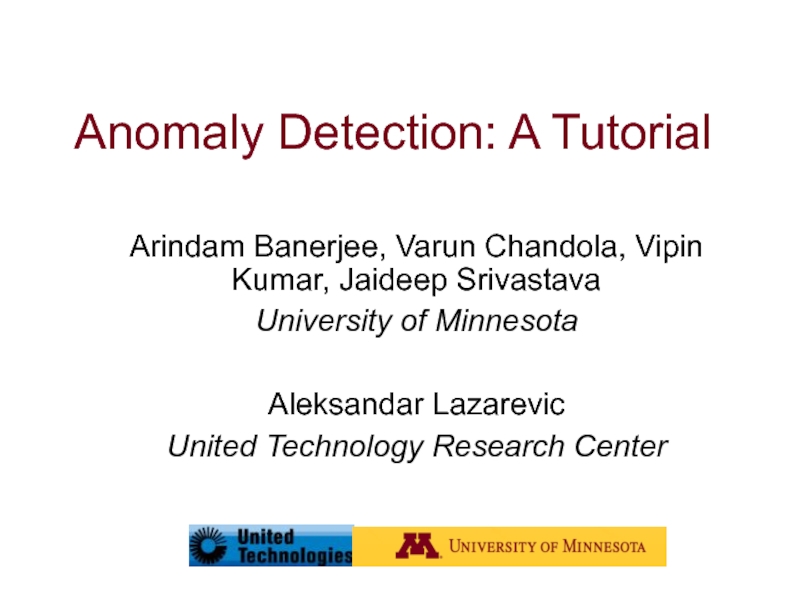
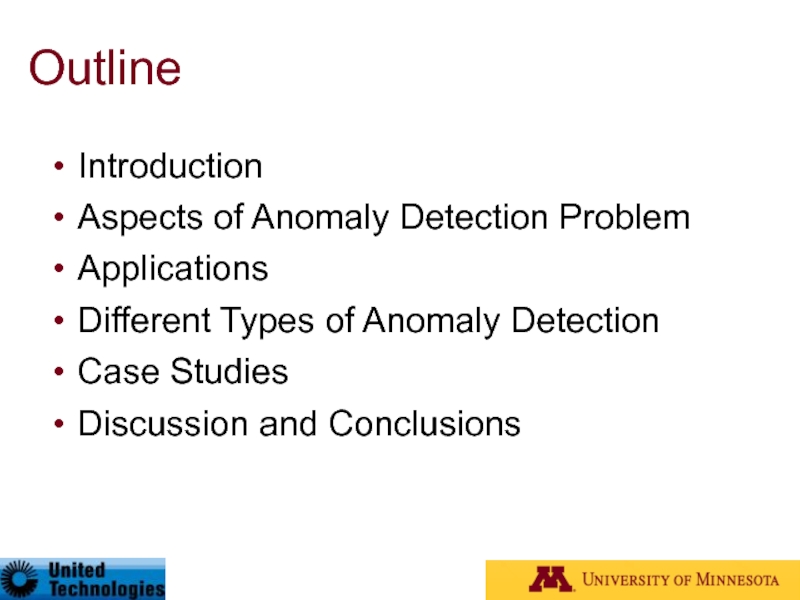
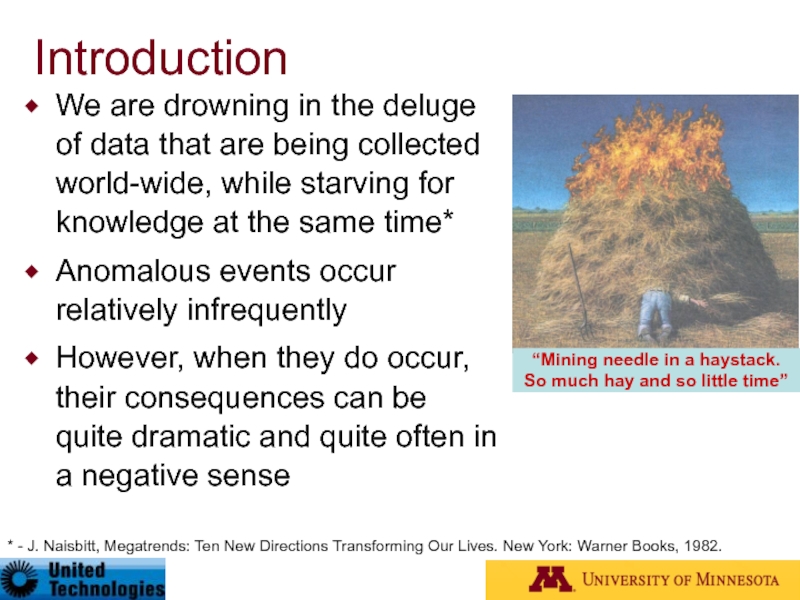

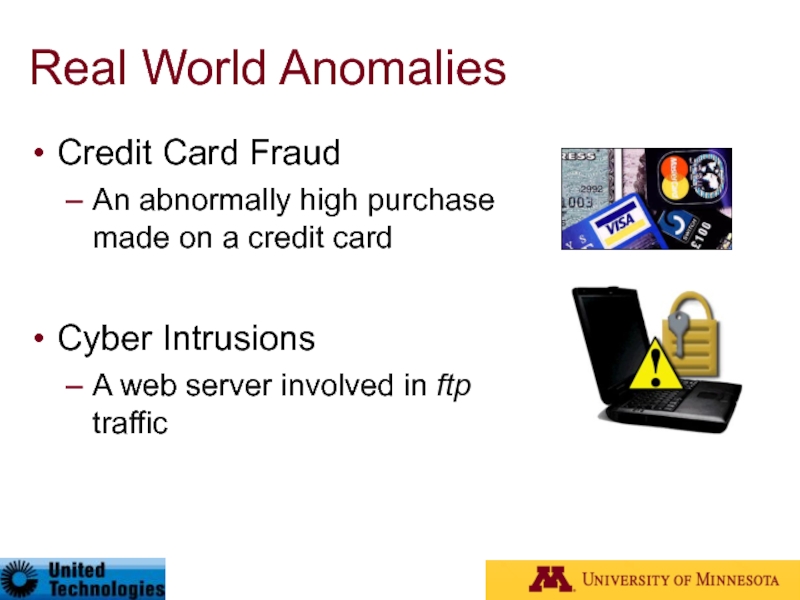
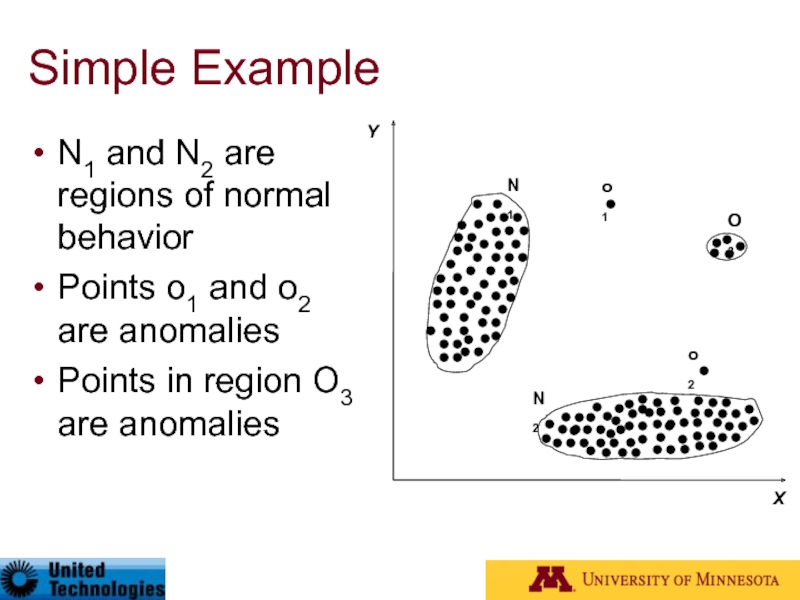
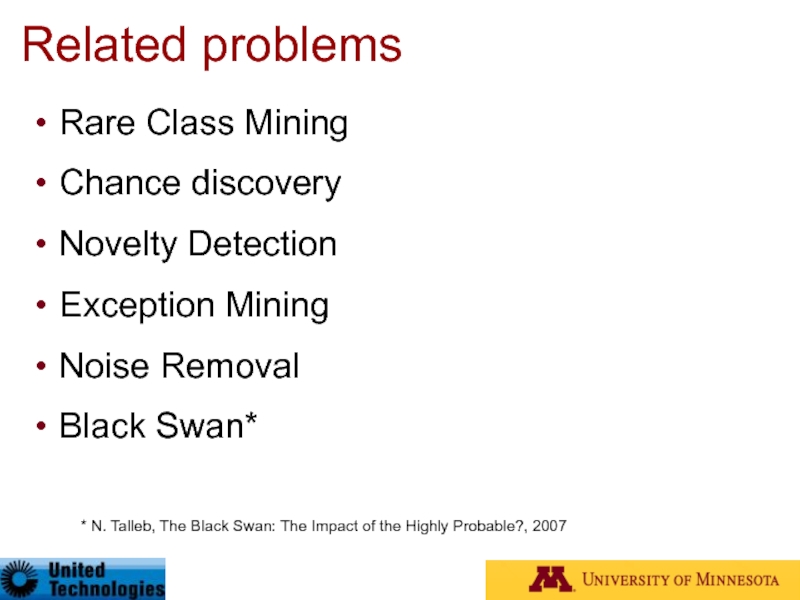
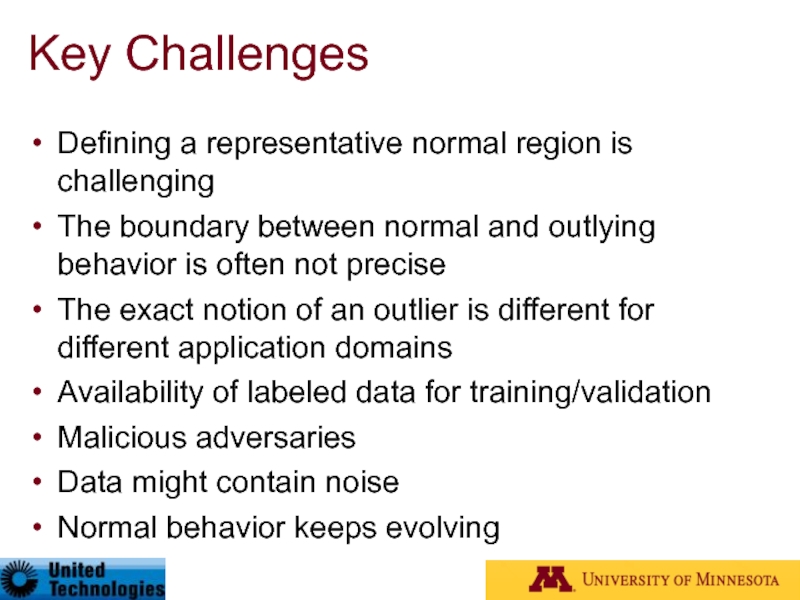
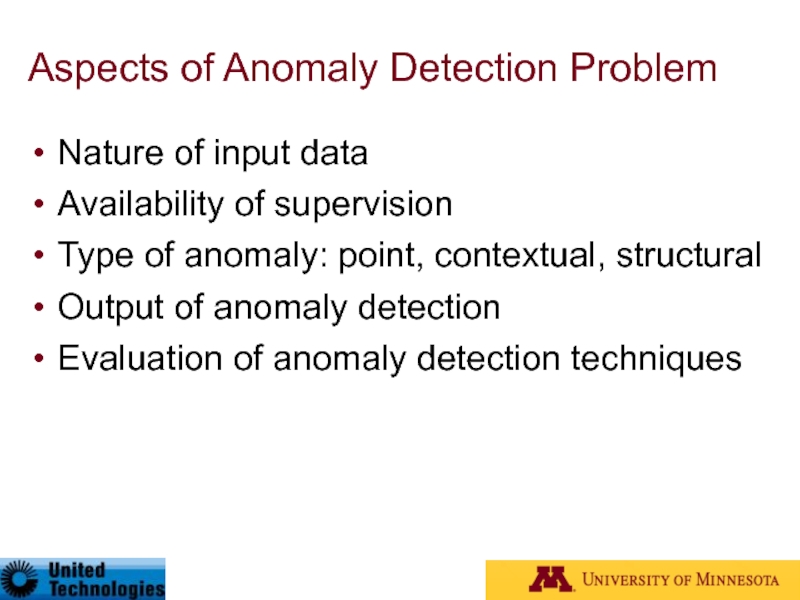
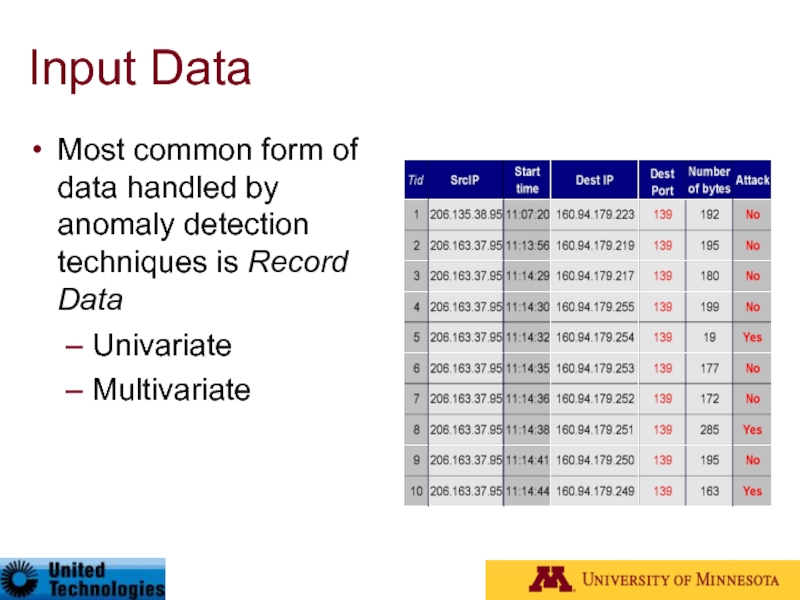
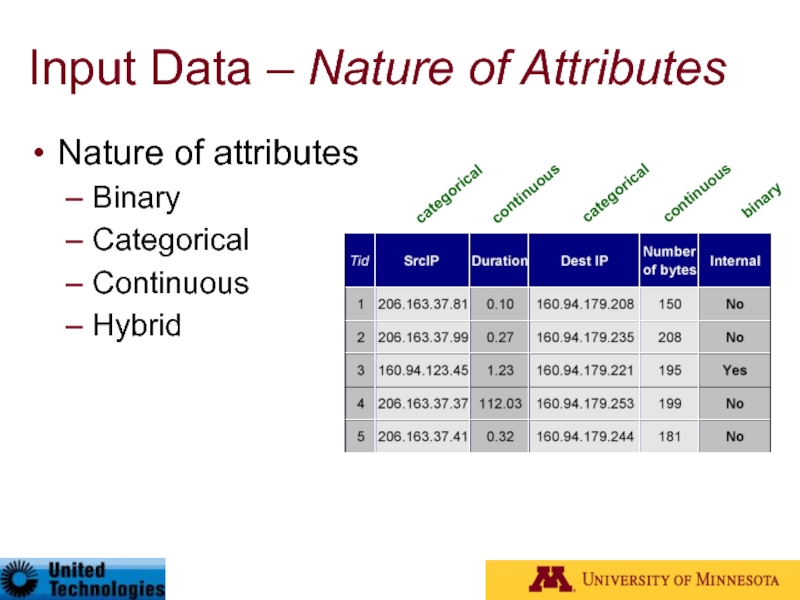

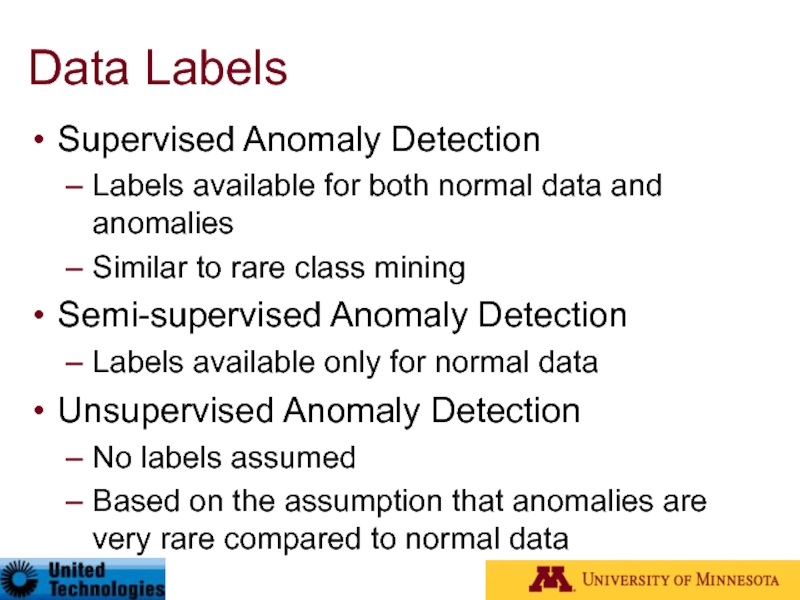

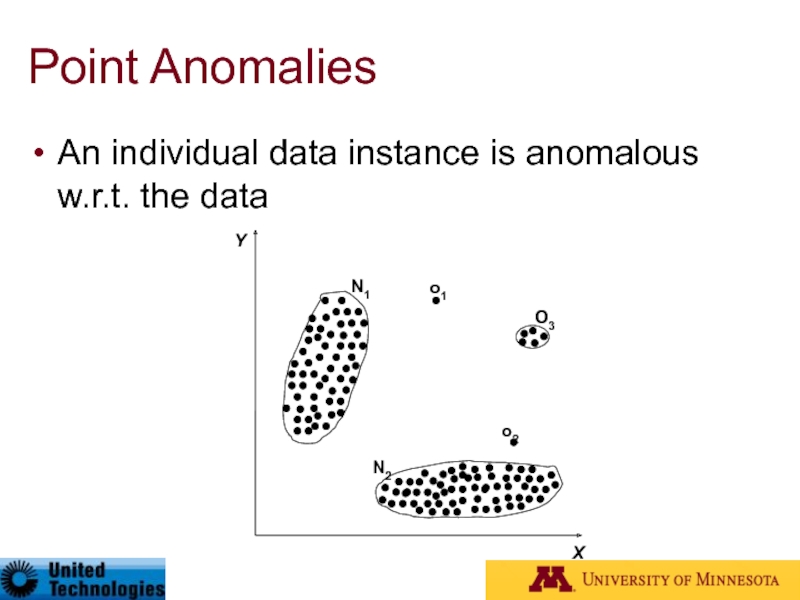
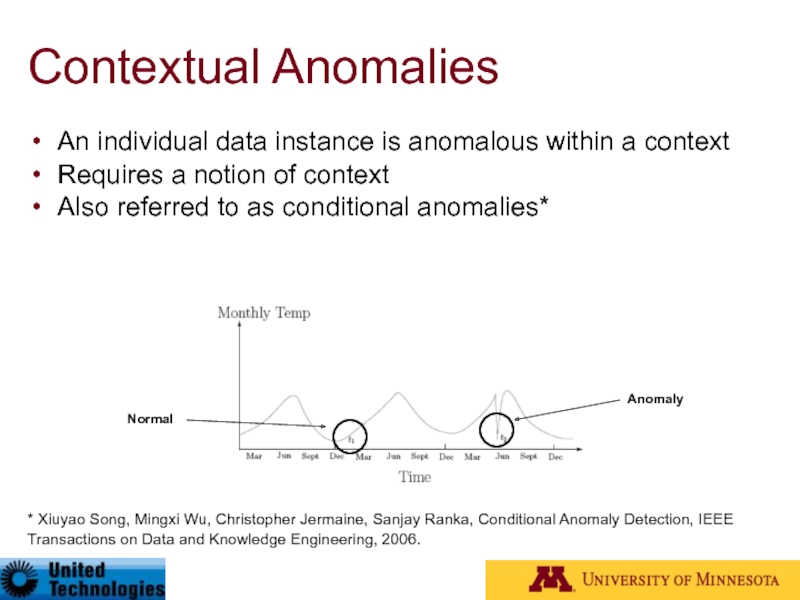

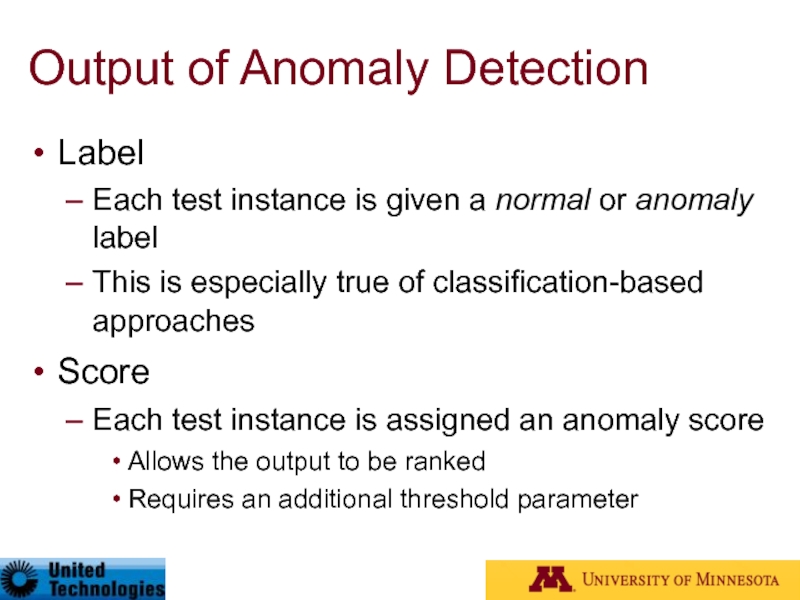

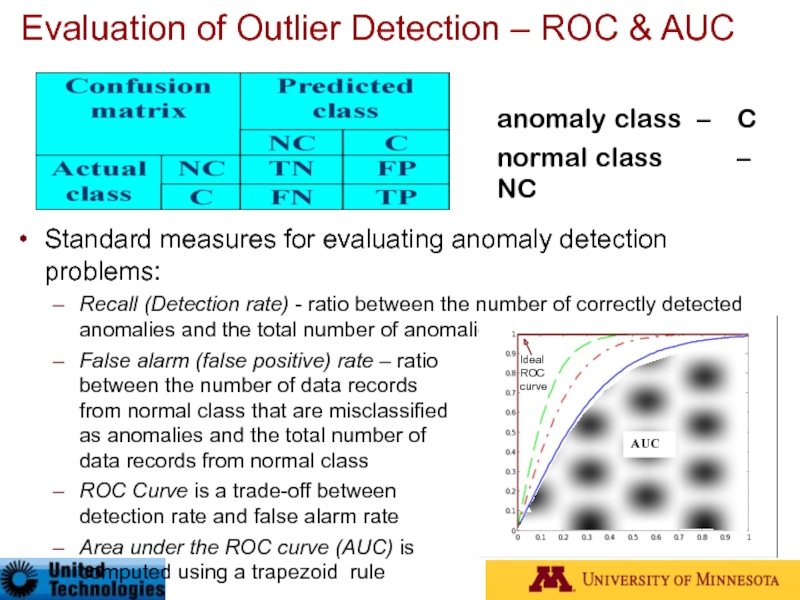
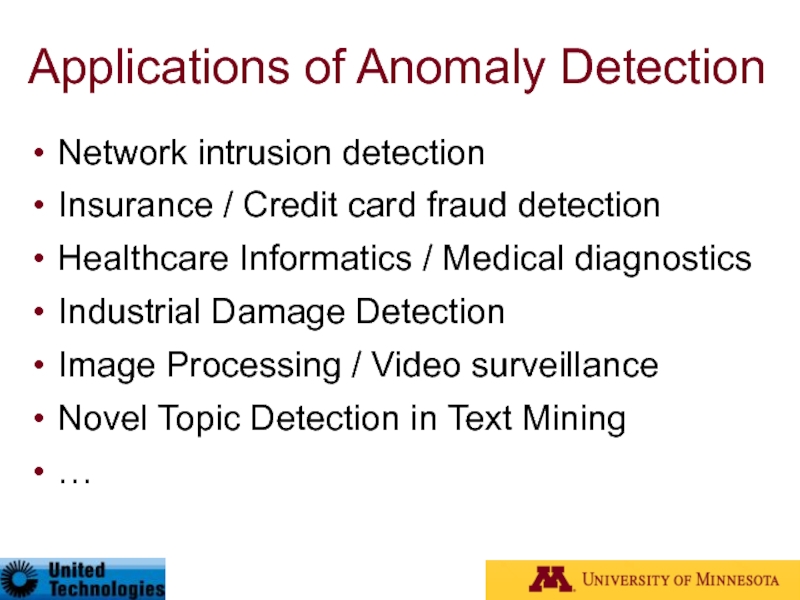

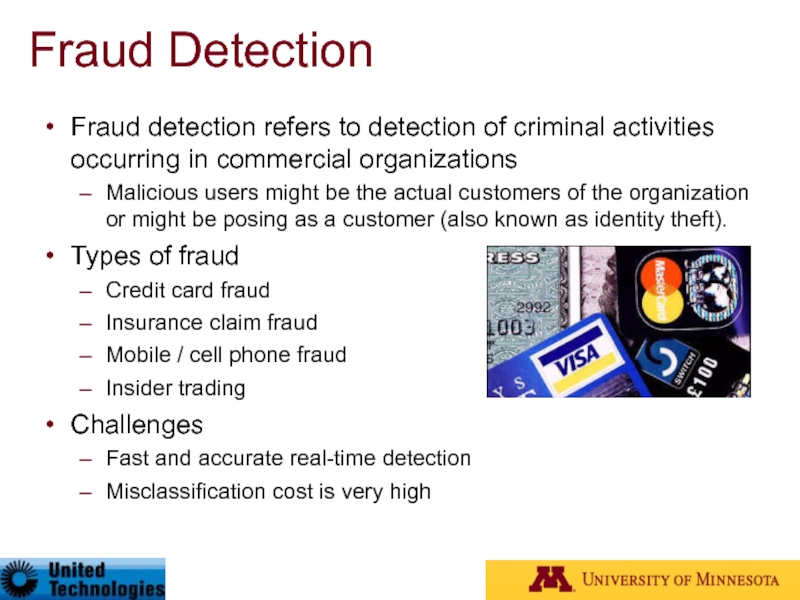
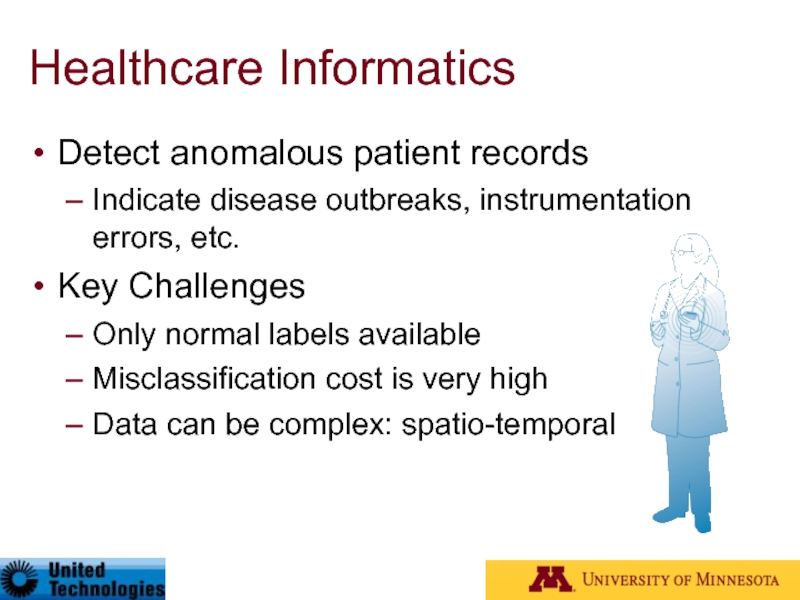
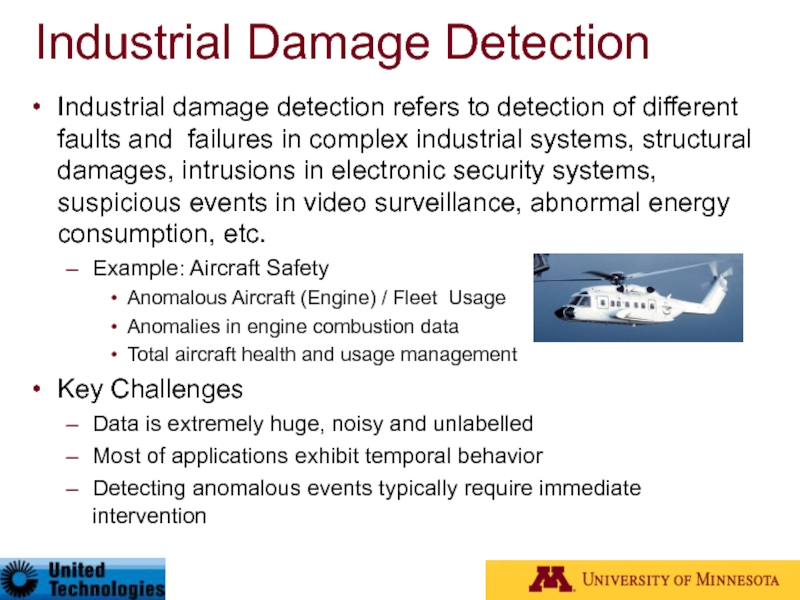
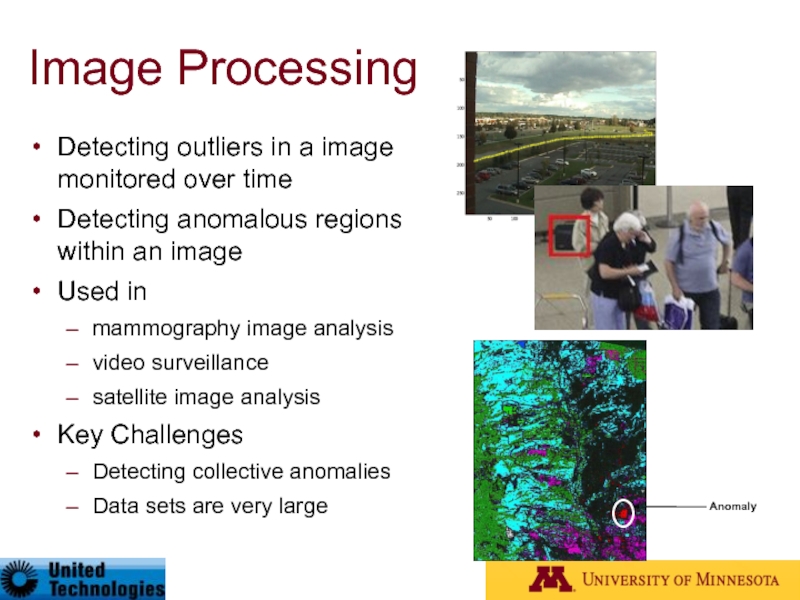
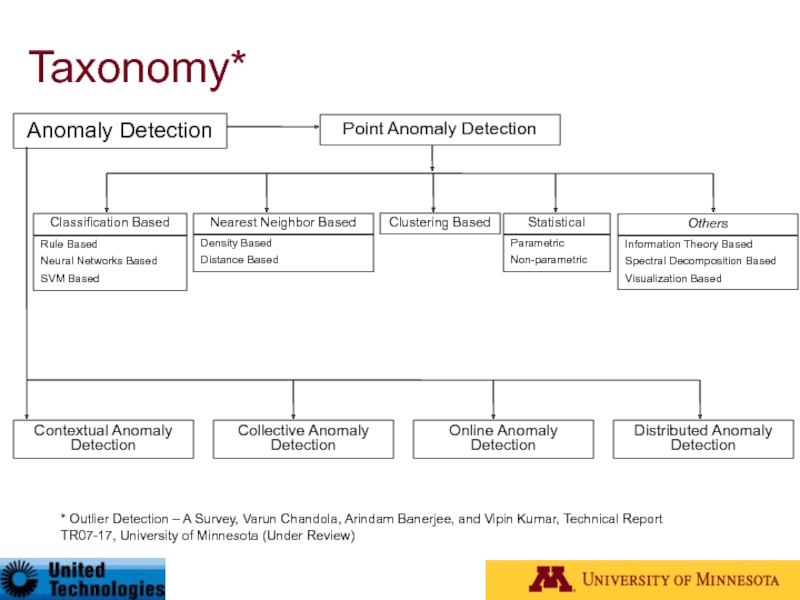
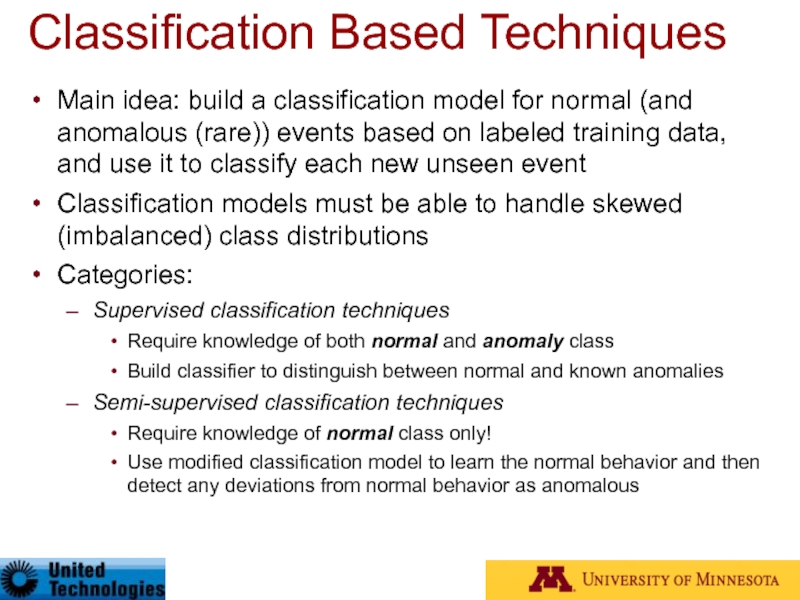
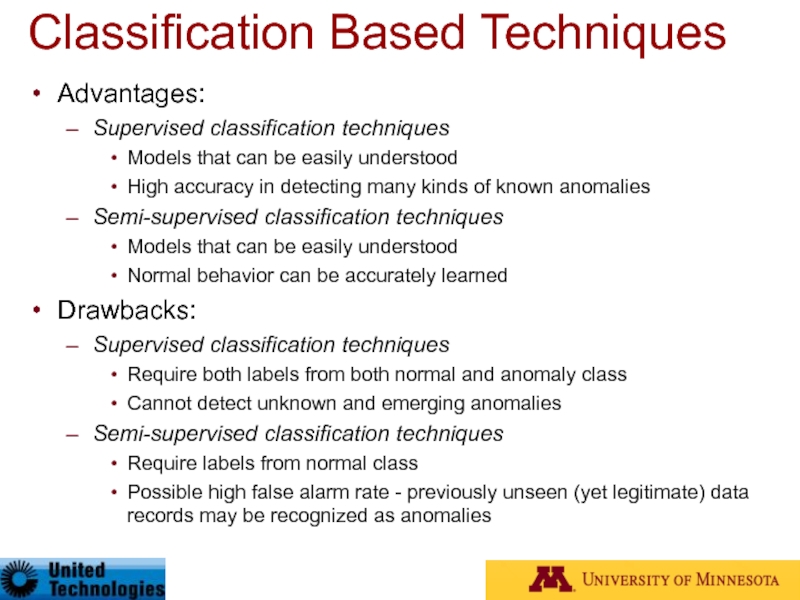
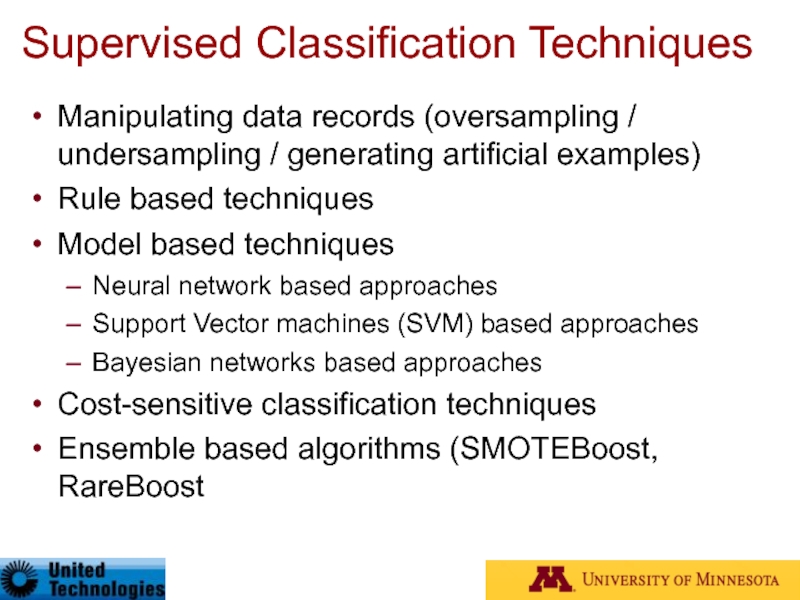
![Manipulating Data RecordsOver-sampling the rare class [Ling98]Make the duplicates of the rare events until the](/img/tmb/3/234416/718725cbecb698108f90a59d02bf1562-800x.jpg)
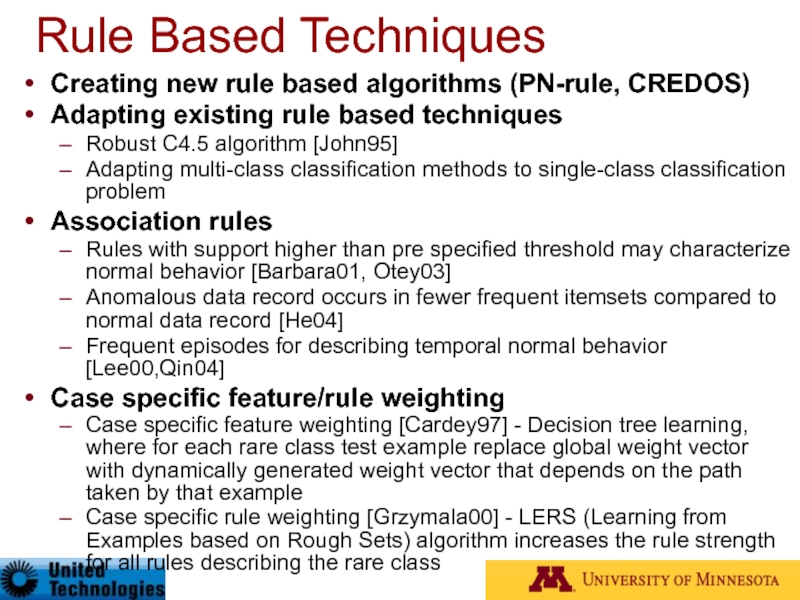
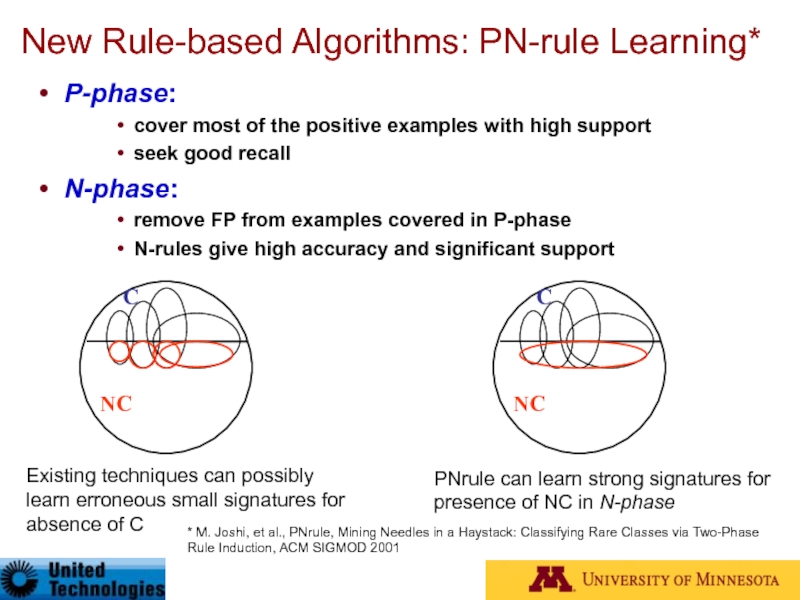
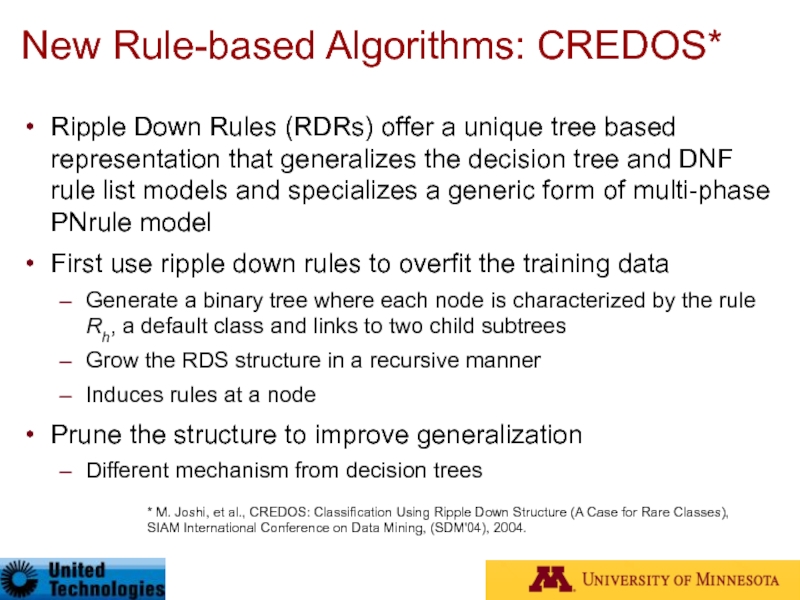
![Using Neural NetworksMulti-layer PerceptronsMeasuring the activation of output nodes [Augusteijn02]Extending the learning beyond decision boundariesEquivalent](/img/tmb/3/234416/8d694ab1d61ed5a5cca7523ab844b9e4-800x.jpg)
![Using Support Vector MachinesSVM Classifiers [Steinwart05,Mukkamala02]Main idea [Steinwart05] :Normal data records belong to high density](/img/tmb/3/234416/5bcde638ff04cc299fe97741ed727d24-800x.jpg)
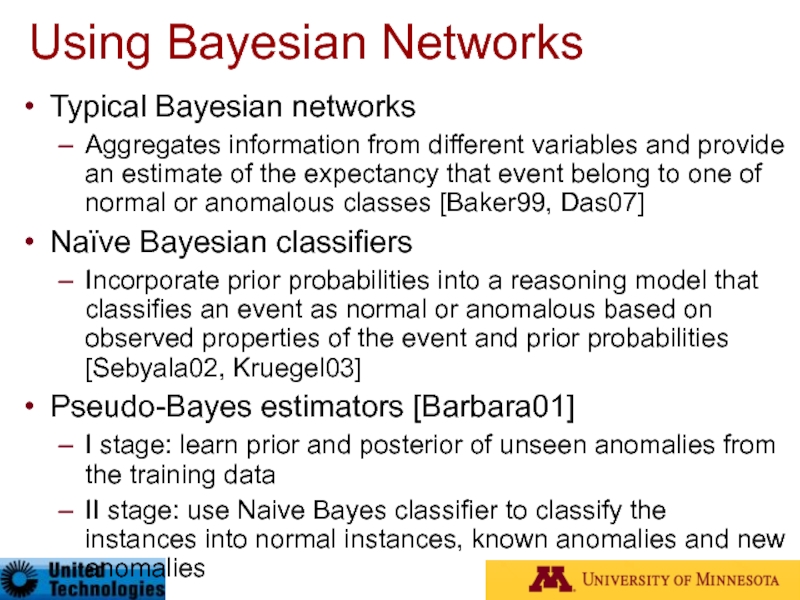
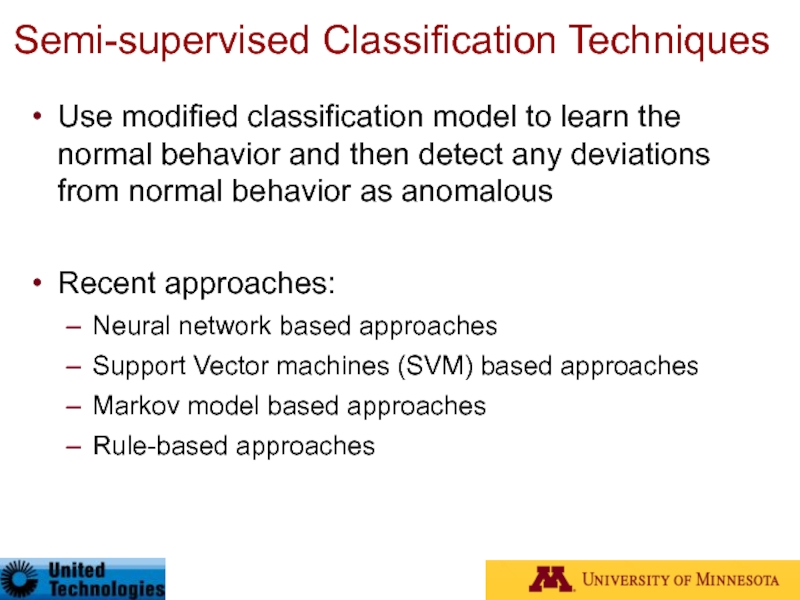
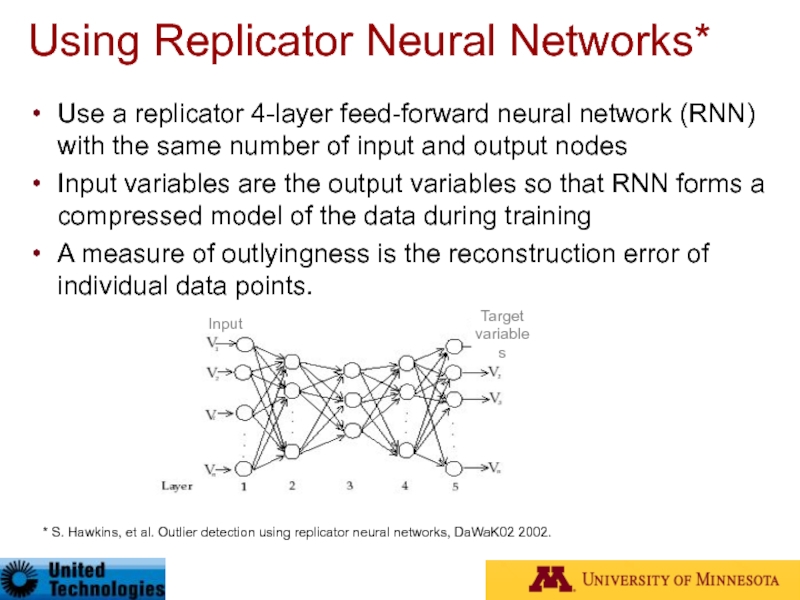
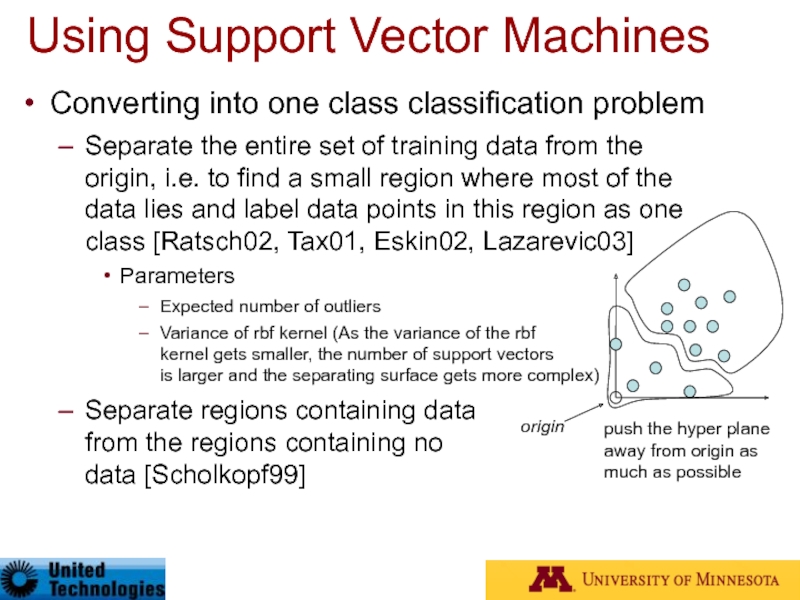
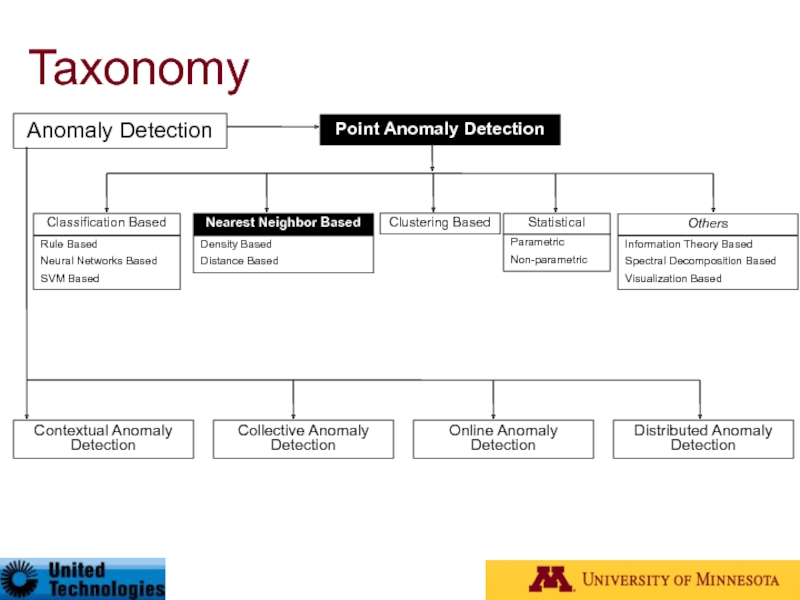

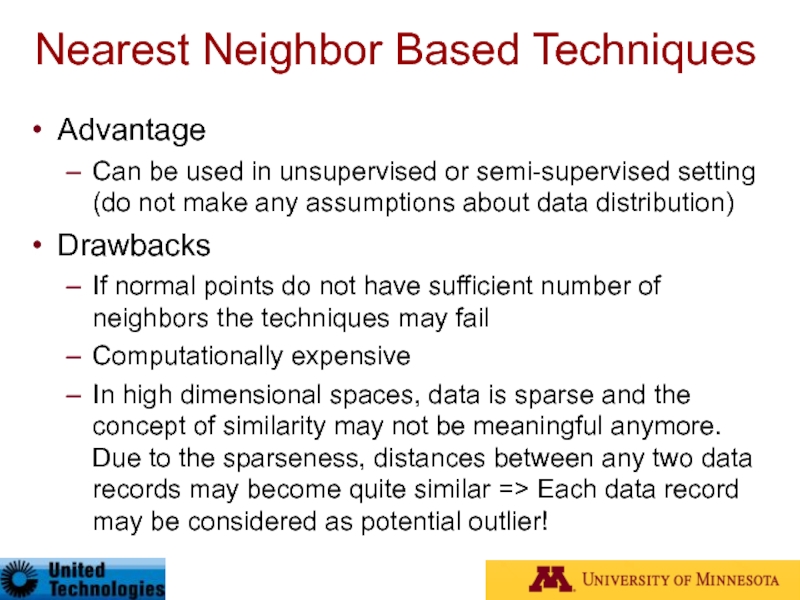
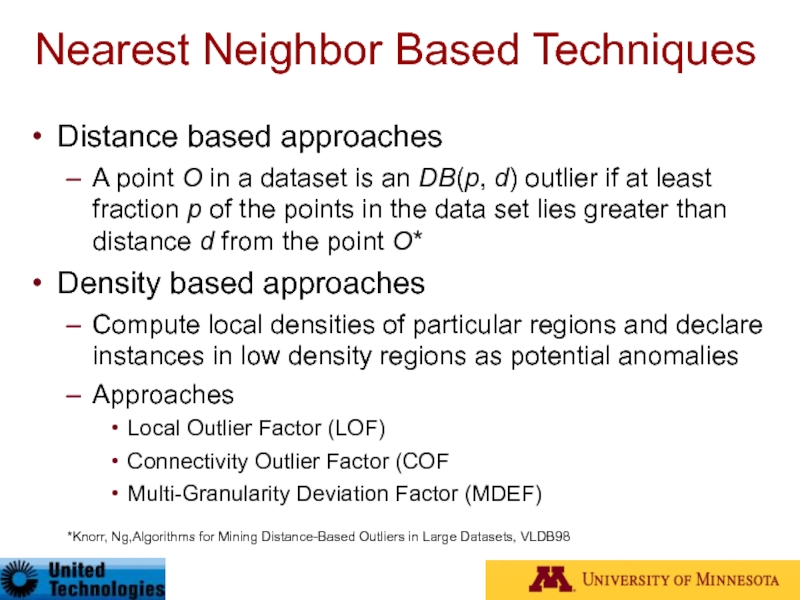
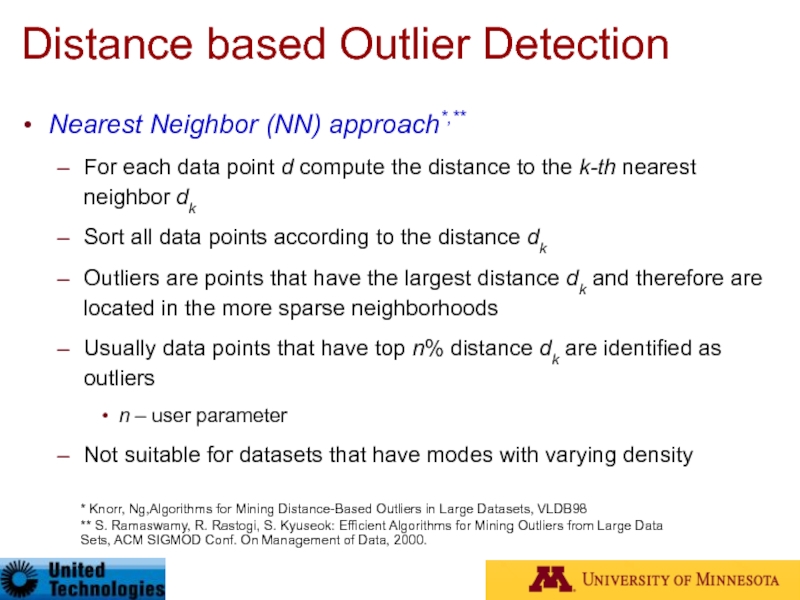
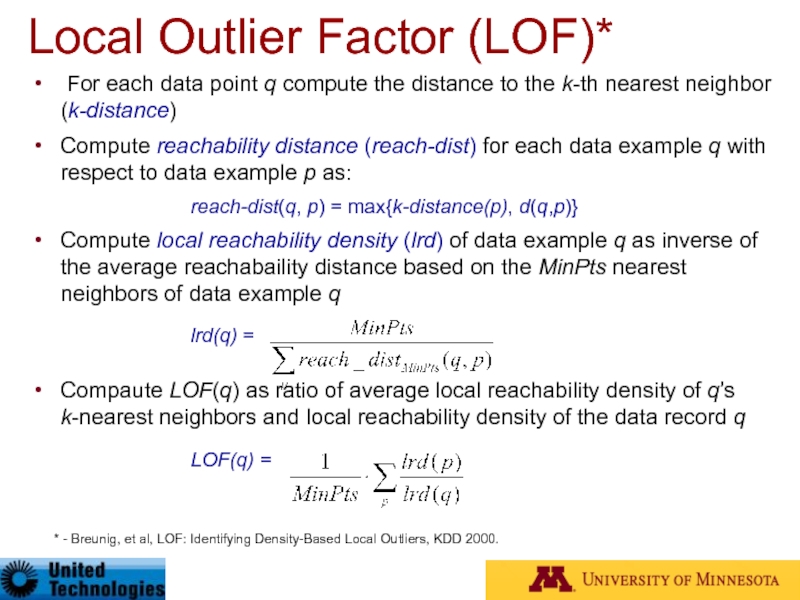
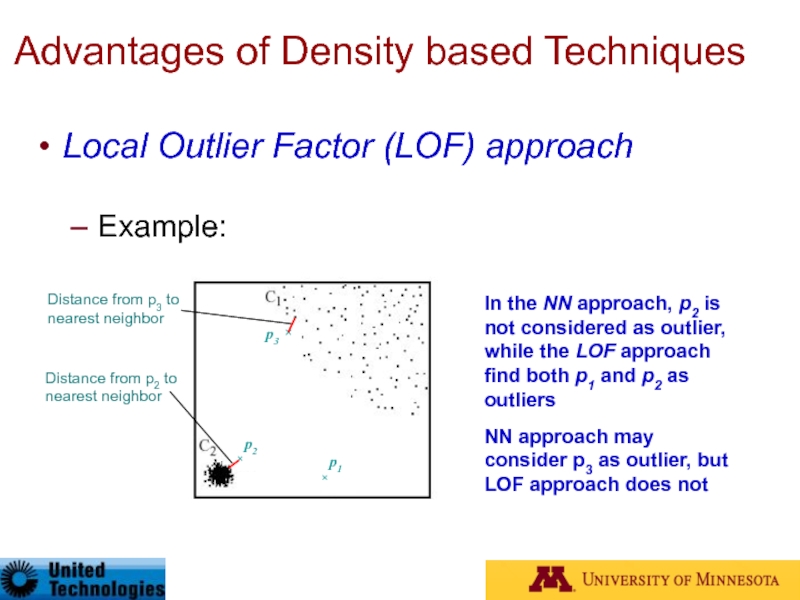
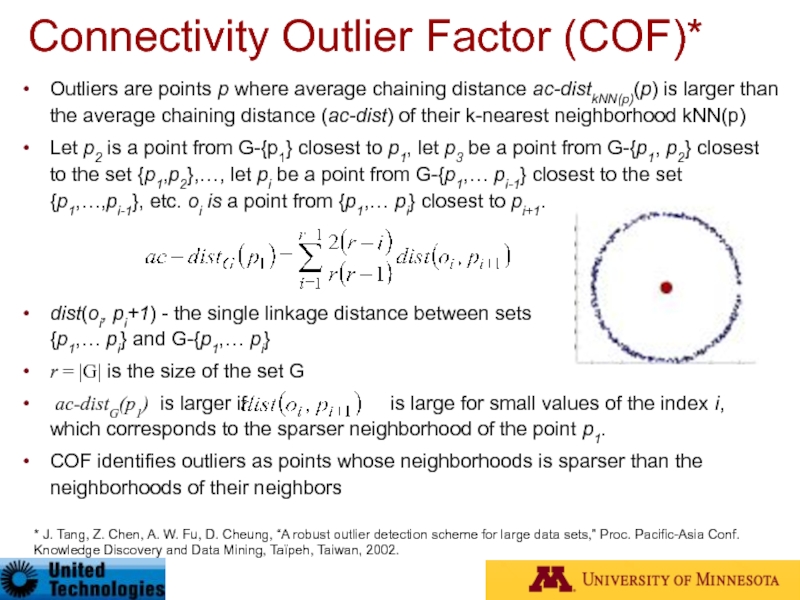

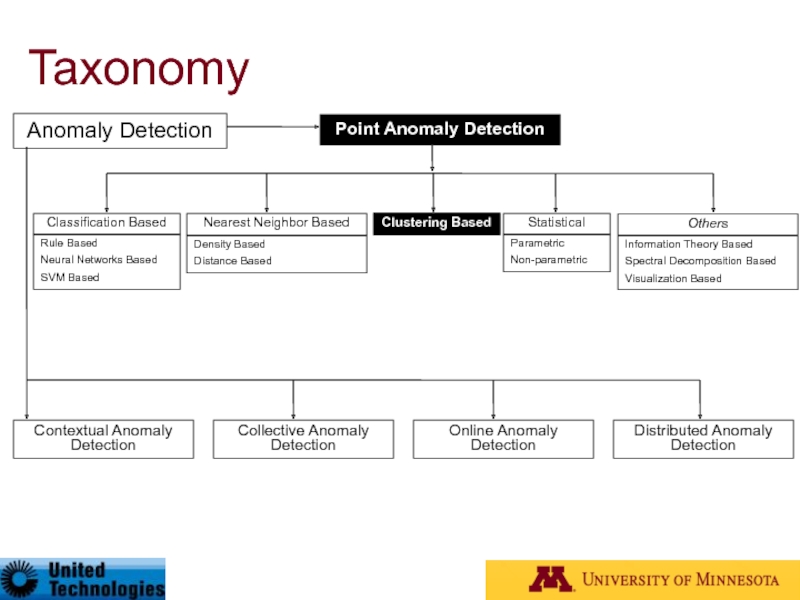
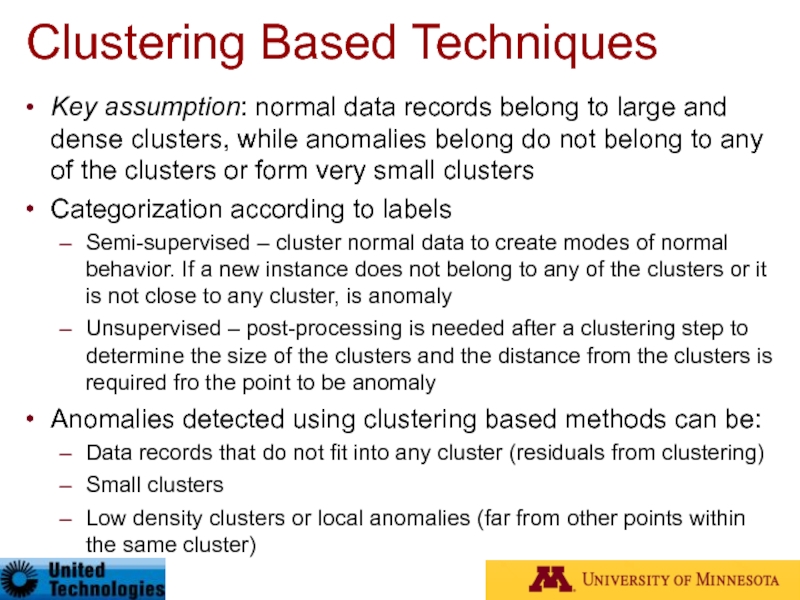
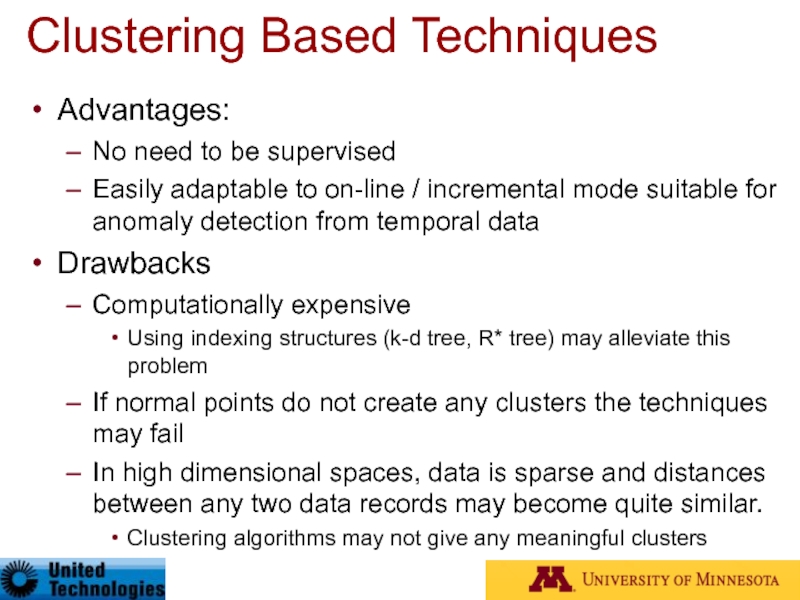
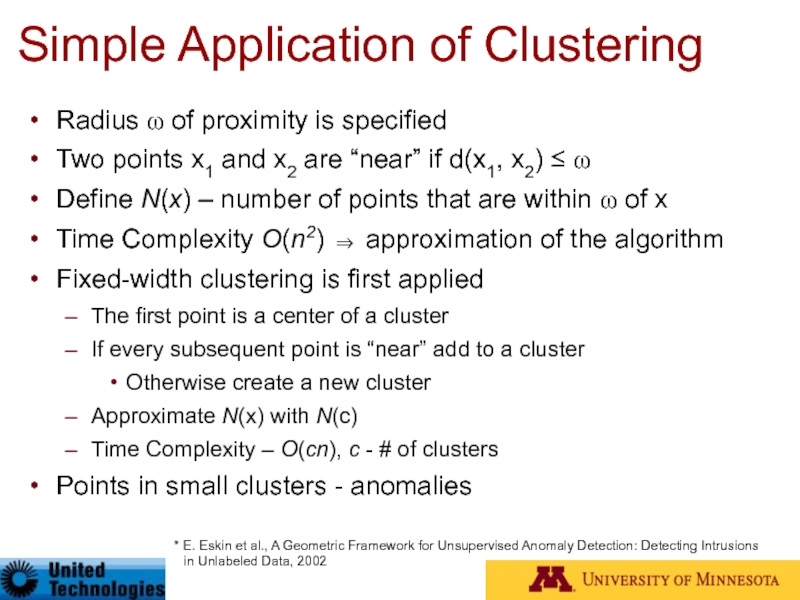
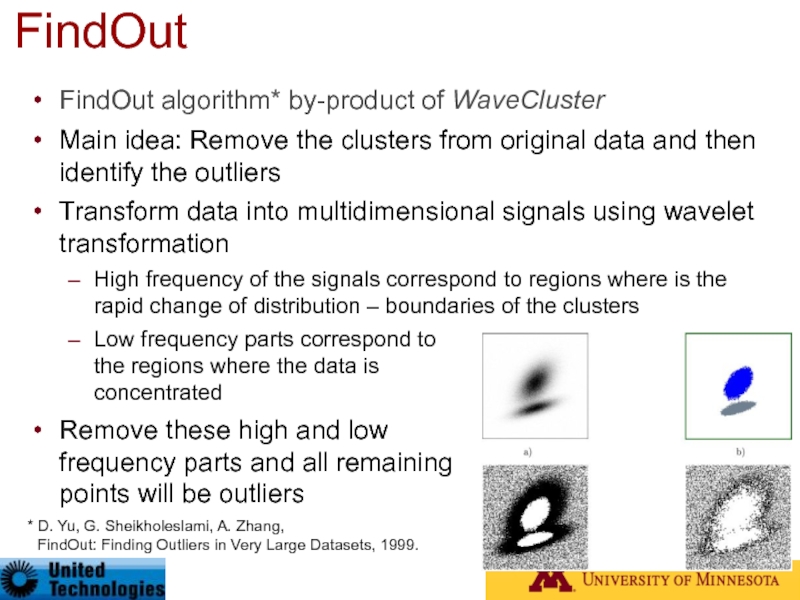
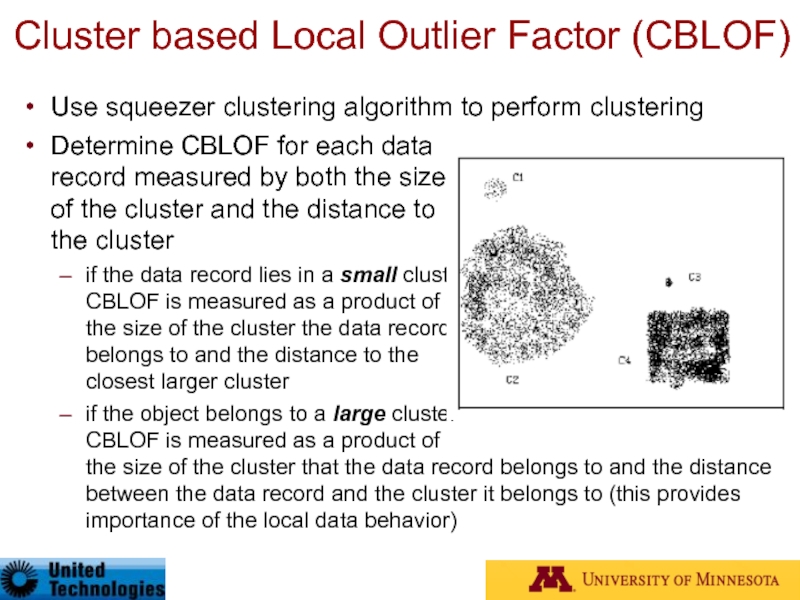
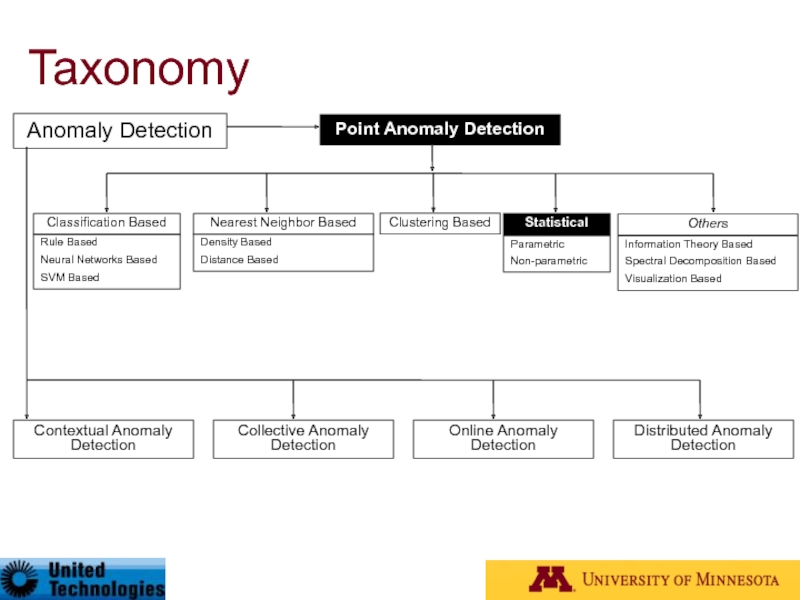
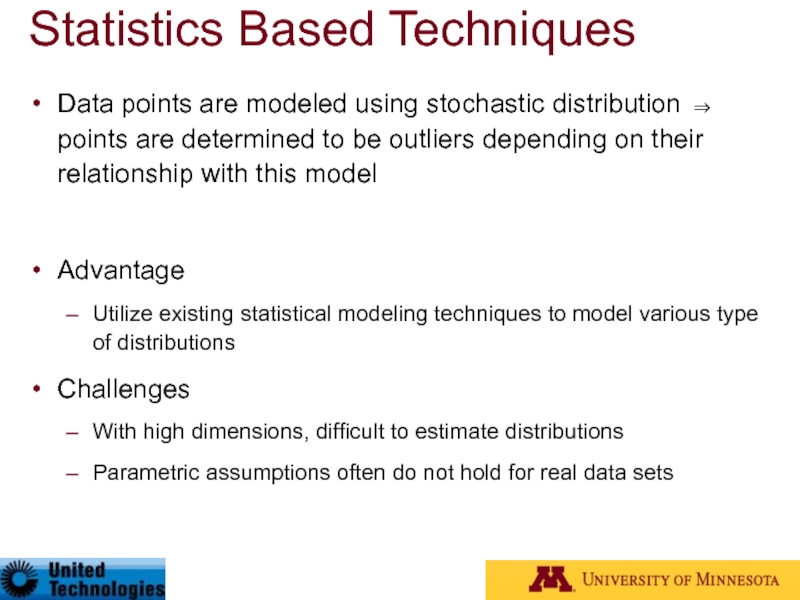
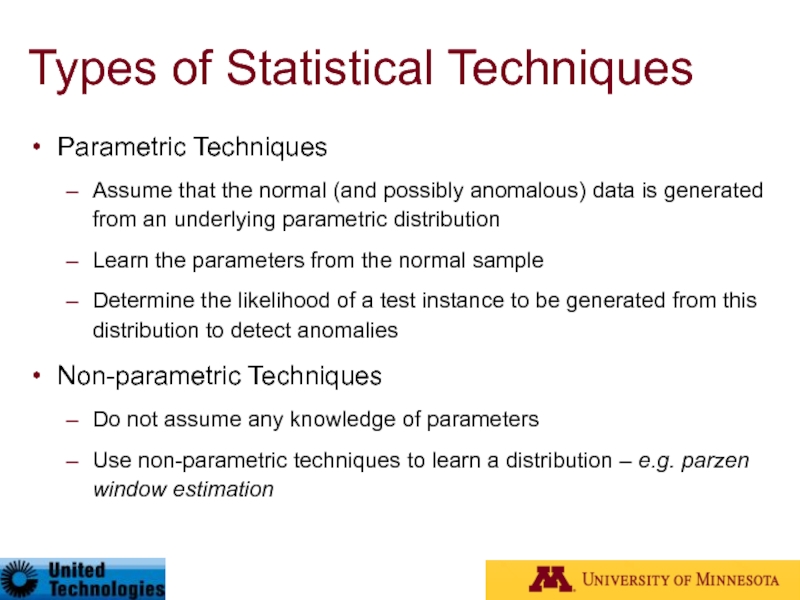
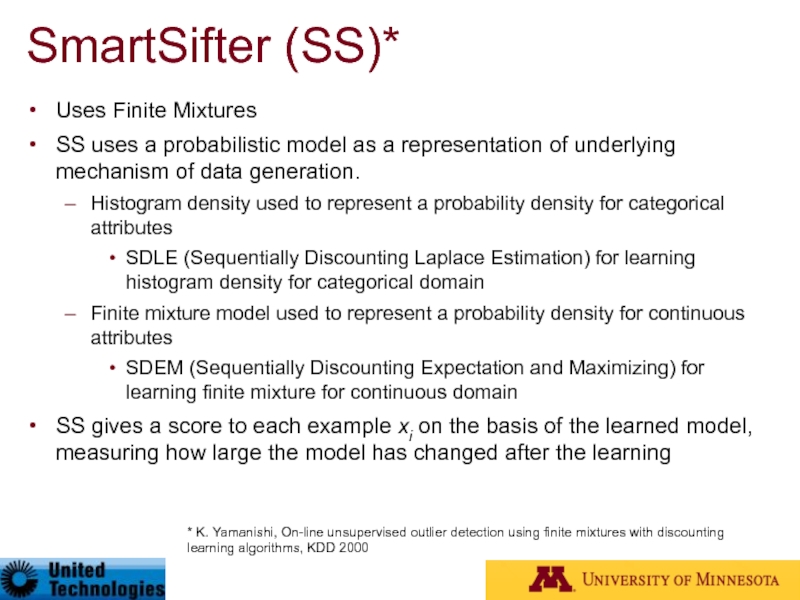
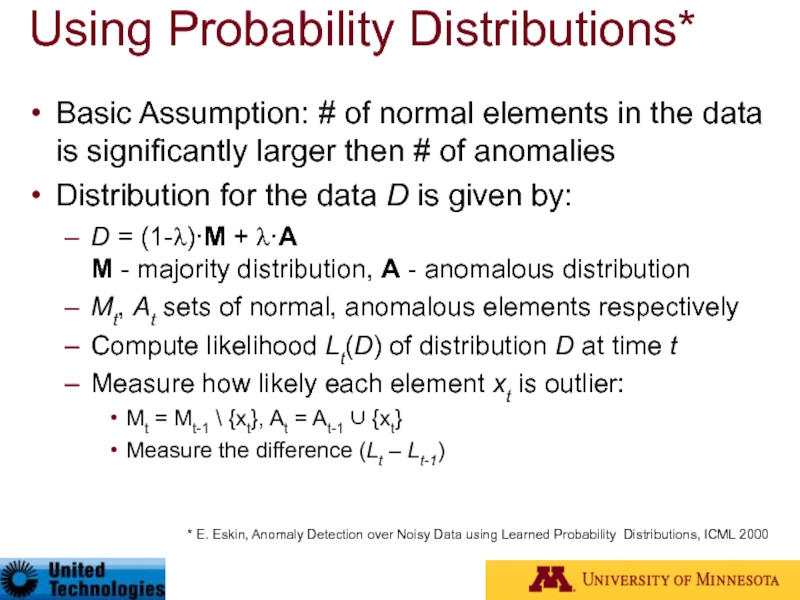
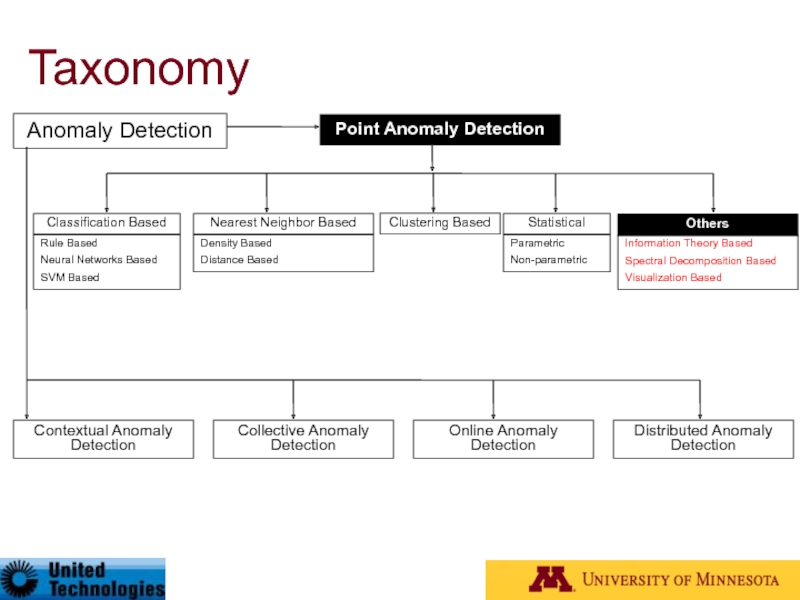
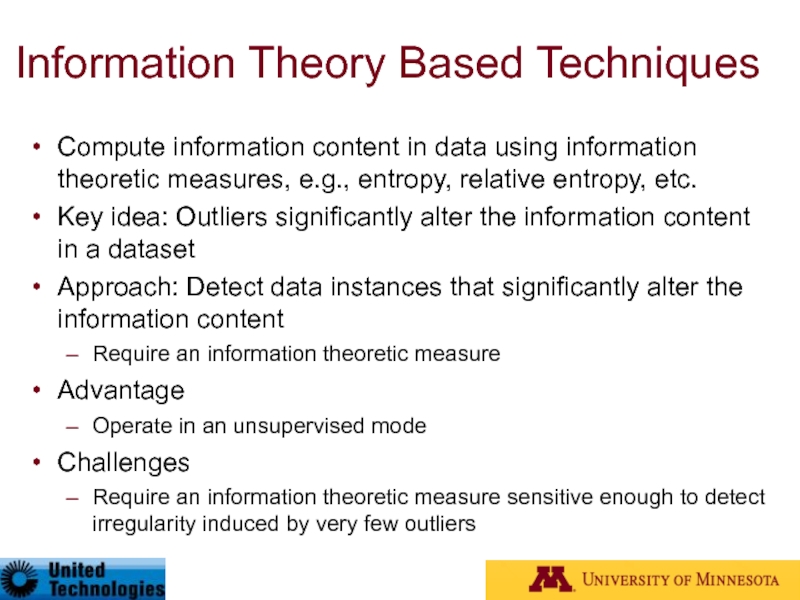
![Using a variety of information theoretic measures [Lee01]Kolmogorov complexity based approaches [Arning96]Detect smallest data subset](/img/tmb/3/234416/a190c1bbb8482a796d553a2ad4605988-800x.jpg)

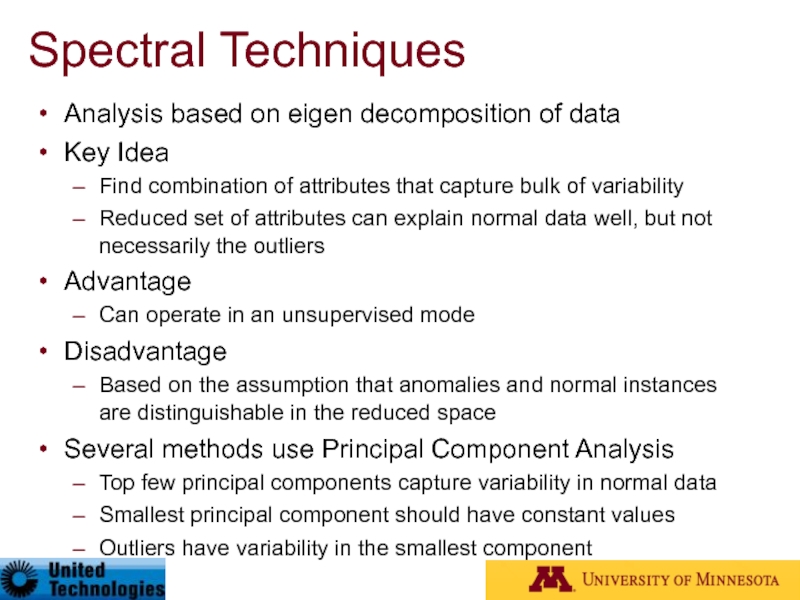
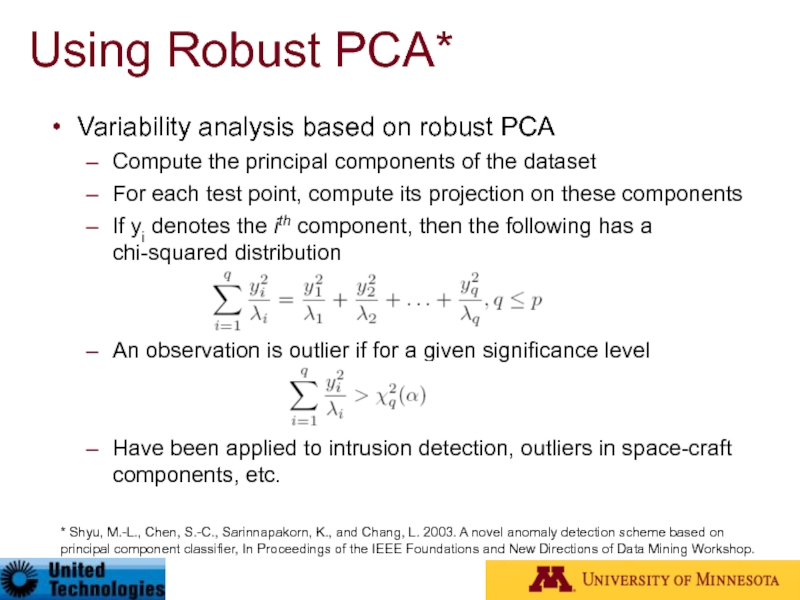
![Temporal analysis of dynamic graphs Based on principal component analysis [Ide04]Applied to network traffic data](/img/tmb/3/234416/0da1871d1abe3e523bbd4757510d373b-800x.jpg)
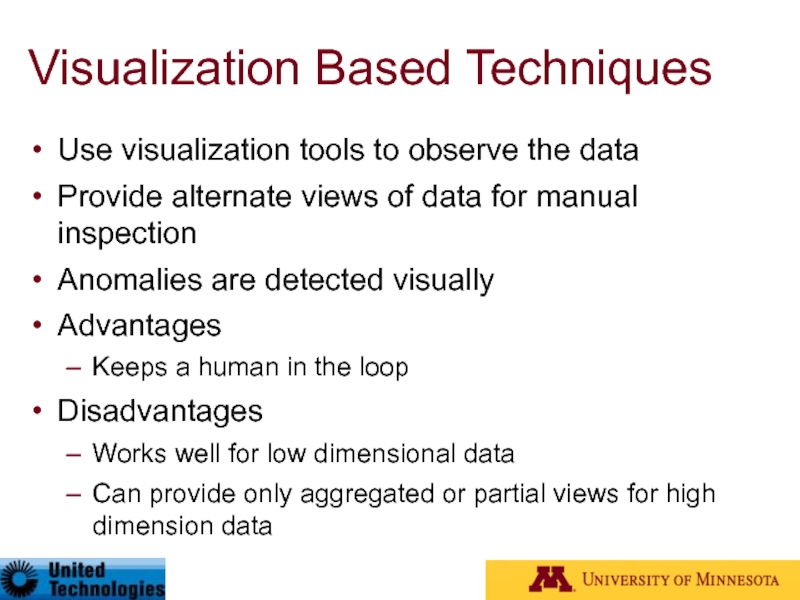
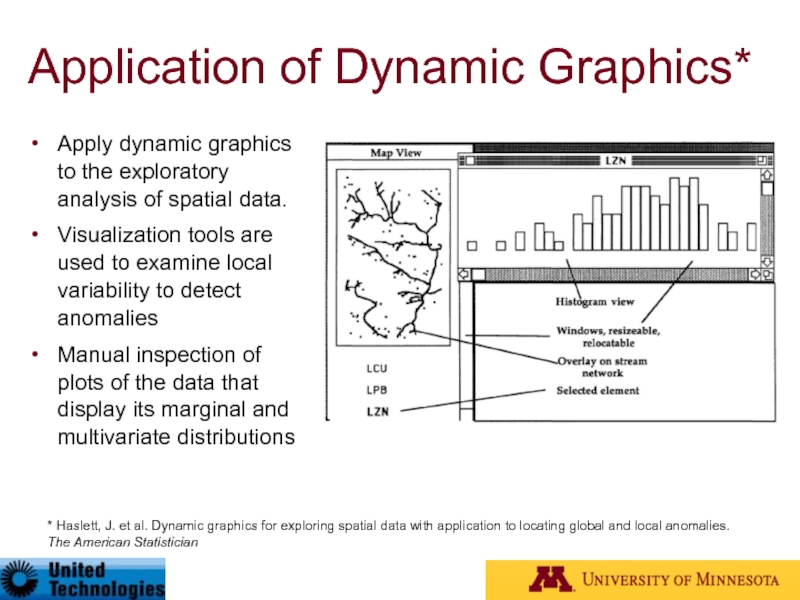
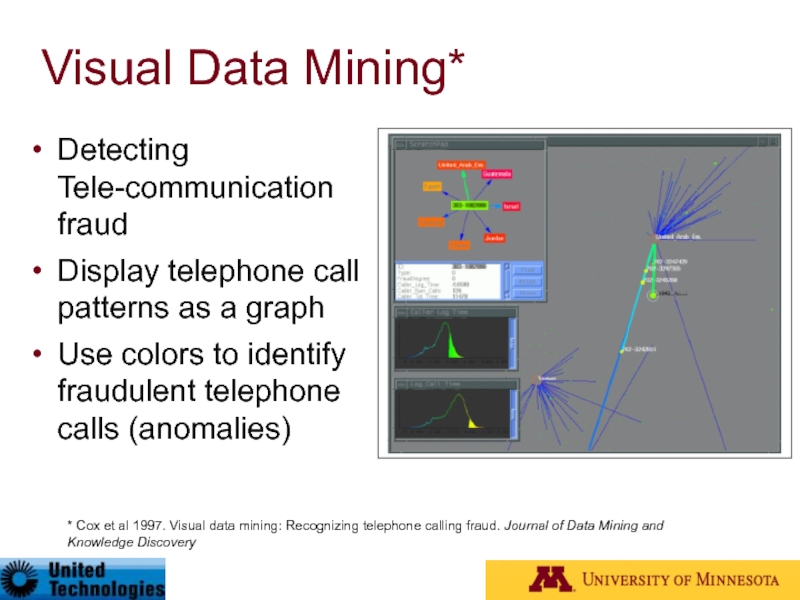
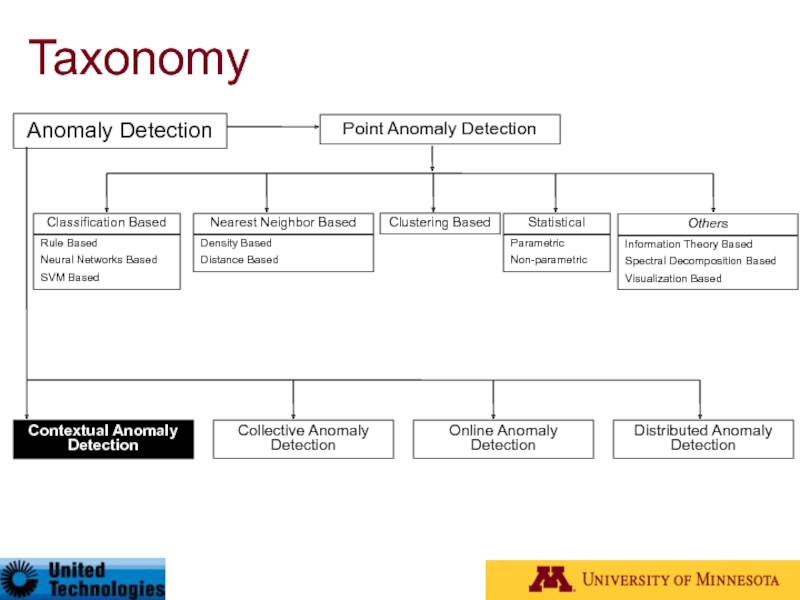

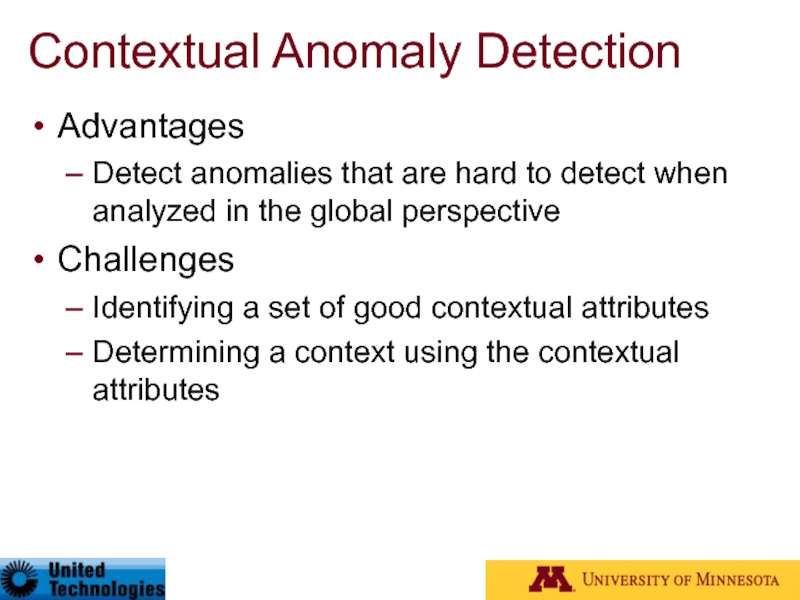
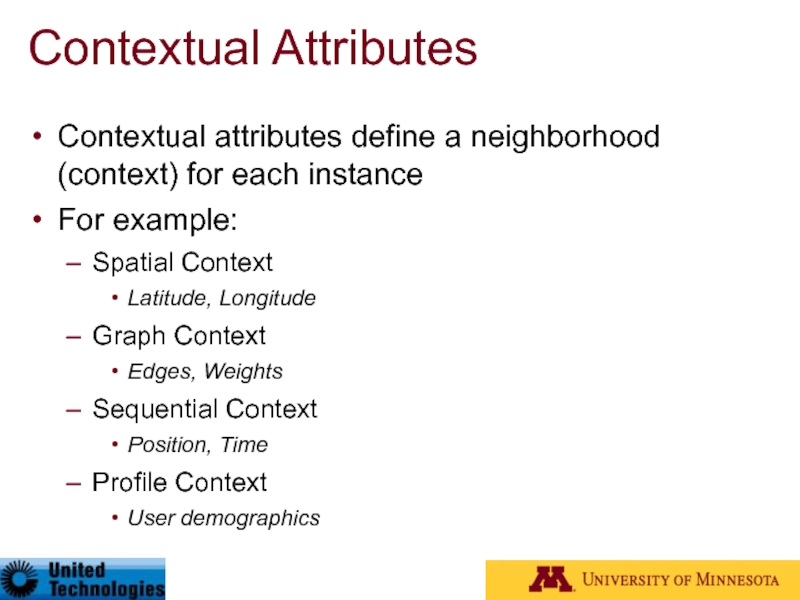
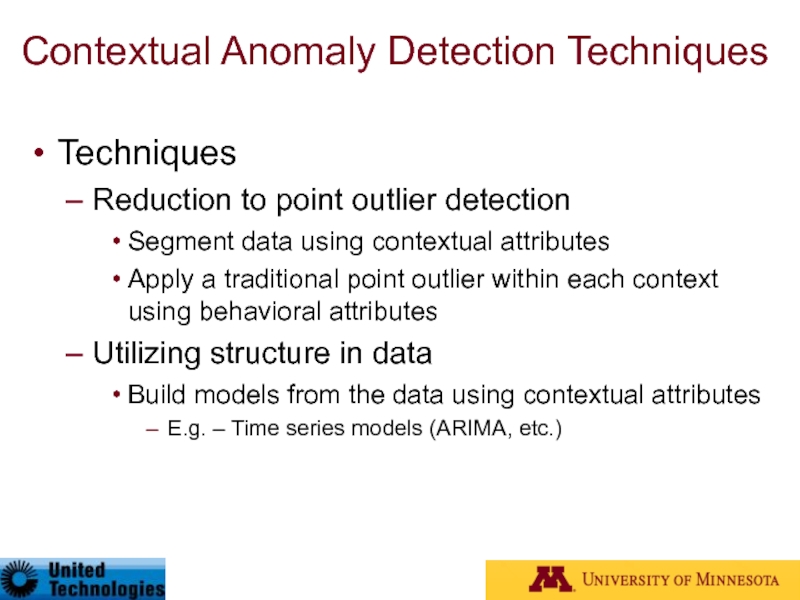
![Conditional Anomaly Detection*Each data point is represented as [x,y], where x denotes the environmental (contextual)](/img/tmb/3/234416/d4d76a39afa18f1582212aa8238bd0d6-800x.jpg)
